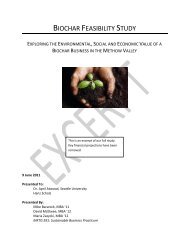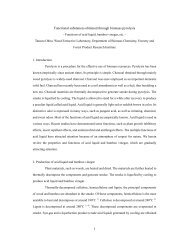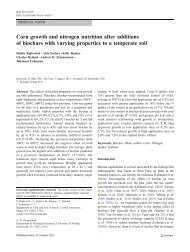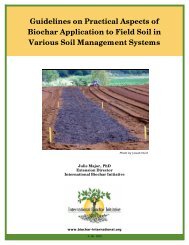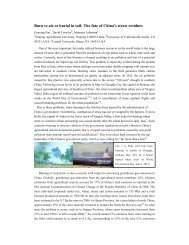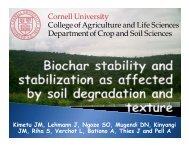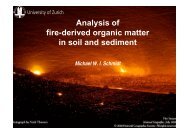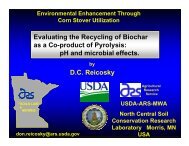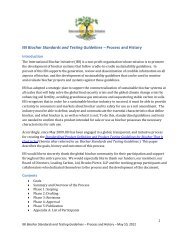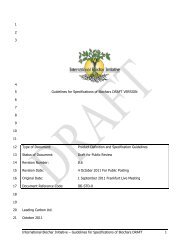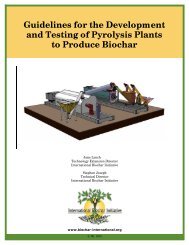Guidelines for Specifications of Biochars for Use in Soils FINAL ...
Guidelines for Specifications of Biochars for Use in Soils FINAL ...
Guidelines for Specifications of Biochars for Use in Soils FINAL ...
Create successful ePaper yourself
Turn your PDF publications into a flip-book with our unique Google optimized e-Paper software.
1234567<strong>Guidel<strong>in</strong>es</strong> <strong>for</strong> <strong>Specifications</strong> <strong>of</strong> <strong>Biochars</strong> <strong>for</strong> <strong>Use</strong> <strong>in</strong> <strong>Soils</strong>DRAFT VERSION891011121314Type <strong>of</strong> Document:Status <strong>of</strong> Document:Product Def<strong>in</strong>ition and Specification <strong>Guidel<strong>in</strong>es</strong>Draft <strong>for</strong> Public Review15Revision Number: 0.716171819Revision Date:Orig<strong>in</strong>al Date:Document Reference Code:10 January 2012 For Public Post<strong>in</strong>g4 October 2011 For Public Post<strong>in</strong>gIBI-STD-02021International Biochar Initiative, Lead<strong>in</strong>g Carbon Ltd.January 2012International Biochar Initiative – <strong>Guidel<strong>in</strong>es</strong> <strong>for</strong> <strong>Specifications</strong> <strong>of</strong> <strong>Biochars</strong> <strong>for</strong> <strong>Use</strong> <strong>in</strong> <strong>Soils</strong> 1
12345678910111213141516171819DisclaimerThe International Biochar Initiative (IBI) <strong>Guidel<strong>in</strong>es</strong> <strong>for</strong> <strong>Specifications</strong> <strong>of</strong> <strong>Biochars</strong> <strong>for</strong> <strong>Use</strong> <strong>in</strong> <strong>Soils</strong>have been prepared with the <strong>in</strong>tent <strong>of</strong> provid<strong>in</strong>g stakeholders and commercial entities withguidel<strong>in</strong>es to specify biochar materials accord<strong>in</strong>g to relevant, reliable, and measurablecharacteristics. Producers who follow these <strong>Guidel<strong>in</strong>es</strong> <strong>for</strong> <strong>Specifications</strong> <strong>of</strong> <strong>Biochars</strong> <strong>for</strong> <strong>Use</strong> <strong>in</strong><strong>Soils</strong> do so voluntarily. In no way shall the IBI or its associates be responsible <strong>for</strong> the use ormisuse <strong>of</strong> <strong>in</strong><strong>for</strong>mation and guidance provided <strong>in</strong> this document. This document prescribes testsand thresholds to identify certa<strong>in</strong> qualities and characteristics <strong>of</strong> biochar materials. No portion<strong>of</strong> this document is <strong>in</strong>tended <strong>for</strong> use as a susta<strong>in</strong>ability or production process guidel<strong>in</strong>e. Furtherdocumentation and guidance is necessary to identify appropriate susta<strong>in</strong>ability practices and/orsafe and effective production processes.The benefits <strong>of</strong> a given biochar material vary widely with the material and with crop, soil, andclimate factors. This document makes no claims regard<strong>in</strong>g the potential benefits <strong>of</strong> any givenbiochar material <strong>in</strong> any particular application. Caution and careful <strong>in</strong>vestigation is warrantedwhen select<strong>in</strong>g biochar <strong>for</strong> an application.The IBI <strong>Guidel<strong>in</strong>es</strong> <strong>for</strong> <strong>Specifications</strong> <strong>of</strong> <strong>Biochars</strong> <strong>for</strong> <strong>Use</strong> <strong>in</strong> <strong>Soils</strong> are <strong>in</strong>tended to be revised andupdated as the science and body <strong>of</strong> knowledge surround<strong>in</strong>g biochar cont<strong>in</strong>ues to evolve. Pleaseensure that you are us<strong>in</strong>g the most up-to-date version found on the website <strong>of</strong> the InternationalBiochar Initiative: http://www.biochar-<strong>in</strong>ternational.org.2021222324252627282930313233343536ForewordThe <strong>Guidel<strong>in</strong>es</strong> <strong>for</strong> <strong>Specifications</strong> <strong>of</strong> <strong>Biochars</strong> <strong>for</strong> <strong>Use</strong> <strong>in</strong> <strong>Soils</strong> provide a standardized def<strong>in</strong>ition <strong>of</strong>biochar and biochar characteristics related to the use <strong>of</strong> biochar as a soil amendment. Theyhave been developed by the International Biochar Initiative (IBI) <strong>in</strong> collaboration with a widevariety <strong>of</strong> <strong>in</strong>dustry and academic experts and through public <strong>in</strong>put on an <strong>in</strong>ternational level.The <strong>Guidel<strong>in</strong>es</strong> <strong>for</strong> <strong>Specifications</strong> <strong>of</strong> <strong>Biochars</strong> <strong>for</strong> <strong>Use</strong> <strong>in</strong> <strong>Soils</strong> were created to encourage furtherdevelopment <strong>of</strong> the biochar <strong>in</strong>dustry by provid<strong>in</strong>g standardized <strong>in</strong><strong>for</strong>mation regard<strong>in</strong>g thecharacterization <strong>of</strong> biochar materials to assist <strong>in</strong> achiev<strong>in</strong>g more consistent levels <strong>of</strong> productquality. In addition to provid<strong>in</strong>g product def<strong>in</strong>ition and qualitative specification guidel<strong>in</strong>es, thisdocument has been developed to ensure that consumers have consistent access to credible<strong>in</strong><strong>for</strong>mation regard<strong>in</strong>g qualitative and physicochemical properties <strong>of</strong> biochar.The <strong>Guidel<strong>in</strong>es</strong> <strong>for</strong> <strong>Specifications</strong> <strong>of</strong> <strong>Biochars</strong> <strong>for</strong> <strong>Use</strong> <strong>in</strong> <strong>Soils</strong> are designed to support an IBIcertification program. Separately, the <strong>Guidel<strong>in</strong>es</strong> are also <strong>in</strong>tended <strong>for</strong> use by various nationaland regional product standards bodies, and national and regional biochar groups <strong>for</strong> their ownlocal adaptation and use, and as a reference <strong>in</strong> regulatory situations, as may be appropriate.IBI developed the <strong>Guidel<strong>in</strong>es</strong> <strong>for</strong> <strong>Specifications</strong> <strong>of</strong> <strong>Biochars</strong> <strong>for</strong> <strong>Use</strong> <strong>in</strong> <strong>Soils</strong> <strong>in</strong> a transparentprocess open to public participation, review, and <strong>in</strong>put. Throughout the development processInternational Biochar Initiative – <strong>Guidel<strong>in</strong>es</strong> <strong>for</strong> <strong>Specifications</strong> <strong>of</strong> <strong>Biochars</strong> <strong>for</strong> <strong>Use</strong> <strong>in</strong> <strong>Soils</strong> 2
123456789101112IBI relied upon the draft<strong>in</strong>g, review, and guidance <strong>of</strong> experts <strong>in</strong> the field, ensur<strong>in</strong>g an efficientpath from concept to f<strong>in</strong>al product, and address<strong>in</strong>g the needs <strong>of</strong> a broad range <strong>of</strong> commercialbiochar producers and end users. As the document was developed, public <strong>in</strong>put from the larger<strong>in</strong>ternational biochar community was cont<strong>in</strong>uously sought to provide a wider perspective on theuse and functionality <strong>of</strong> this tool.The design <strong>of</strong> the <strong>Guidel<strong>in</strong>es</strong> <strong>for</strong> <strong>Specifications</strong> <strong>of</strong> <strong>Biochars</strong> <strong>for</strong> <strong>Use</strong> <strong>in</strong> <strong>Soils</strong> follows current bestpractices and available science. As biochar science cont<strong>in</strong>ues to improve, the <strong>Guidel<strong>in</strong>es</strong> will beupdated <strong>in</strong> an iterative process <strong>in</strong> order to rema<strong>in</strong> current. There<strong>for</strong>e these <strong>Guidel<strong>in</strong>es</strong> and thisdocument will be periodically revised through further consultation with the <strong>in</strong>ternational biocharcommunity.The <strong>Guidel<strong>in</strong>es</strong> <strong>for</strong> the Specification <strong>of</strong> <strong>Biochars</strong> <strong>for</strong> <strong>Use</strong> <strong>in</strong> <strong>Soils</strong> document development processis based on the follow<strong>in</strong>g guid<strong>in</strong>g pr<strong>in</strong>ciples:13141516171819202122Ma<strong>in</strong>ta<strong>in</strong> congruence with best practice guidance <strong>for</strong> standards development such asInternational Standards Organization (ISO), American Society <strong>for</strong> Test<strong>in</strong>g and Materials(ASTM) , and Institute <strong>of</strong> Electrical and Electronics Eng<strong>in</strong>eers (IEEE);Strictly adhere to process, ensur<strong>in</strong>g efficient and effective collaboration;Engage the knowledgeable and diverse stakeholder groups active <strong>in</strong> the biochar<strong>in</strong>dustry;Organize an <strong>in</strong>dependent review committee with broad stakeholder representation,(<strong>in</strong>clud<strong>in</strong>g project developers, environmental non-governmental organizations [ENGOs],researchers, and so on); and,Rely on IBI <strong>in</strong>frastructure and capacity <strong>for</strong> leadership and adm<strong>in</strong>istration <strong>of</strong> the <strong>in</strong>itiative.23242526272829303132The experts charged with <strong>in</strong>itial development <strong>of</strong> <strong>Guidel<strong>in</strong>es</strong> <strong>for</strong> <strong>Specifications</strong> <strong>of</strong> <strong>Biochars</strong> <strong>for</strong> <strong>Use</strong><strong>in</strong> <strong>Soils</strong> took part <strong>in</strong> two phases <strong>of</strong> work<strong>in</strong>g group activities. These consisted <strong>of</strong> Phase 1, an<strong>in</strong>itial review <strong>of</strong> document <strong>for</strong>matt<strong>in</strong>g and characterization criteria, and Phase 2, an <strong>in</strong>-depthdiscussion <strong>of</strong> characterization criteria and report<strong>in</strong>g levels selection. At the end <strong>of</strong> each phase,new draft documents were posted, public comments solicited, reviewed and, as appropriate,<strong>in</strong>corporated <strong>in</strong> subsequent revisions <strong>of</strong> the draft. The work<strong>in</strong>g groups <strong>for</strong> each phase wereorganized as follows:Phase 1: Initial review <strong>of</strong> document <strong>for</strong>matt<strong>in</strong>g and characterization criteria (December 2010 –March 2011)Work<strong>in</strong>g Group #1: North America/South America/Africa33343536Jim Amonette, United StatesJason Aramburu, United StatesLouis de Lange, South AfricaMariam Ekebafe, NigeriaInternational Biochar Initiative – <strong>Guidel<strong>in</strong>es</strong> <strong>for</strong> <strong>Specifications</strong> <strong>of</strong> <strong>Biochars</strong> <strong>for</strong> <strong>Use</strong> <strong>in</strong> <strong>Soils</strong> 3
12345678910 Johannes Lehmann, United States Kim Magr<strong>in</strong>i, United States Hugh McLaughl<strong>in</strong>, Canada René Pigeon, Canada Joseph Pignatello, United States Miguel Rodriguez, Brazil Rogerio Traballi, Brazil Sunguo Wang, CanadaWork<strong>in</strong>g Group #2: Asia/Europe/ Australia/New Zealand11121314151617181920212223Marta Camps, New ZealandThomas Harttung, DenmarkMichael Hayes, IrelandStephen Joseph, AustraliaRupam Kataki, IndiaGuitong Li, Ch<strong>in</strong>aFranco Miglietta, ItalyAmran Salleh, MalaysiaYoshiyuki Sh<strong>in</strong>ogi, JapanBalwant S<strong>in</strong>gh, AustraliaSaran Sohi, United K<strong>in</strong>gdomLukas Van Zwieten, Australia2425Phase 2: Live, <strong>in</strong>-depth review <strong>of</strong> characterization criteria and report<strong>in</strong>g levels selection (July2011)26272829303132Marta Camps, New ZealandStephen Joseph, AustraliaJohannes Lehmann, United StatesCordner Peacocke, United K<strong>in</strong>gdomMichael Sesko, United StatesSaran Sohi, United K<strong>in</strong>gdomEdward Someus, Sweden333435All work<strong>in</strong>g group members from Phases 1 and 2 were <strong>in</strong>vited to review issues highlighted frompublic comments <strong>in</strong> December, 2011 to <strong>in</strong><strong>for</strong>m this revised document <strong>for</strong> January, 2012 publicreview.International Biochar Initiative – <strong>Guidel<strong>in</strong>es</strong> <strong>for</strong> <strong>Specifications</strong> <strong>of</strong> <strong>Biochars</strong> <strong>for</strong> <strong>Use</strong> <strong>in</strong> <strong>Soils</strong> 4
123456789101112131415161718192021222324252627282930Table <strong>of</strong> ContentsDisclaimer 2Foreword 2Table <strong>of</strong> Contents 51 Scope 62 Terms and Def<strong>in</strong>itions 73 Biomass Feedstock Material and Biochar Production 93.1 General Feedstock Material Requirements 93.2 General Biochar Production and Material Handl<strong>in</strong>g Recommendations 94 Biochar Material Test Categories and Characteristics 104.1 Test Category A – Basic Utility Properties 124.2 Test Categories B and C – Basic and Supplemental Tox<strong>in</strong> Report<strong>in</strong>g 144.3 Test Category D - Advanced Analysis and Soil Enhancement Properties 165 Product Label<strong>in</strong>g Instructions 175.1 Label<strong>in</strong>g Requirements 175.2 Product In<strong>for</strong>mation Requirements 175.3 Special Instructions 176 Con<strong>for</strong>mity and Record Keep<strong>in</strong>g 176.1 Tim<strong>in</strong>g and Frequency <strong>of</strong> Test<strong>in</strong>g 186.2 Laboratory Standards 186.3 Cha<strong>in</strong> <strong>of</strong> Custody 187 References 19Appendix 1 – Sample Biochar Label 22Appendix 2 – Recommended General Sample Analysis Procedures and Protocols <strong>for</strong>Specific Tests 24Appendix 3 – Regulatory Tox<strong>in</strong> Ranges 27Appendix 4 – Determ<strong>in</strong><strong>in</strong>g a “Material Change” <strong>in</strong> Feedstock 29Appendix 5 – The <strong>Use</strong> <strong>of</strong> H:C org to Indicate C Stability 31Appendix 6 – Glossary 33International Biochar Initiative – <strong>Guidel<strong>in</strong>es</strong> <strong>for</strong> <strong>Specifications</strong> <strong>of</strong> <strong>Biochars</strong> <strong>for</strong> <strong>Use</strong> <strong>in</strong> <strong>Soils</strong> 5
12345678910111213141516171819202122232425262728293031321 ScopeIssued by the International Biochar Initiative (IBI) and based on <strong>in</strong>ternational consultation, this<strong>Guidel<strong>in</strong>es</strong> <strong>for</strong> <strong>Specifications</strong> <strong>of</strong> <strong>Biochars</strong> <strong>for</strong> <strong>Use</strong> <strong>in</strong> <strong>Soils</strong> (here<strong>in</strong>after referred to as Biochar<strong>Guidel<strong>in</strong>es</strong>) document is <strong>in</strong>tended to establish a common def<strong>in</strong>ition <strong>for</strong> biochar, test<strong>in</strong>g andmeasurement methods <strong>for</strong> select physical and chemical properties <strong>of</strong> biochar, and label<strong>in</strong>gguidel<strong>in</strong>es <strong>for</strong> biochar materials.Biochar is a solid material obta<strong>in</strong>ed from the thermochemical conversion <strong>of</strong> biomass <strong>in</strong> anoxygen-limited environment. Biochar can be used as a product itself or as an <strong>in</strong>gredient with<strong>in</strong>a blended product, with a range <strong>of</strong> applications as an agent <strong>for</strong> soil improvement, improvedresource use efficiency, remediation and/or protection aga<strong>in</strong>st particular environmentalpollution, and as an avenue <strong>for</strong> greenhouse gas (GHG) abatement.These Biochar <strong>Guidel<strong>in</strong>es</strong> provide a standardized def<strong>in</strong>ition <strong>of</strong> biochar and biochar characteristicsrelated to the use <strong>of</strong> biochar as a soil amendment. They will serve as the basis <strong>for</strong> an IBIcertification program, and are <strong>in</strong>tended <strong>for</strong> use and adaptation to local conditions andregulations by any nation or region. These Biochar Guidel<strong>in</strong>e support not only basel<strong>in</strong>e safetyconsiderations but also the evolv<strong>in</strong>g understand<strong>in</strong>g <strong>of</strong> the positive functions <strong>of</strong> biochar <strong>in</strong> soil.This document does not prescribe appropriate uses <strong>for</strong> biochar materials, nor provide guidel<strong>in</strong>eson what biochar can or should be used <strong>for</strong>.These Biochar <strong>Guidel<strong>in</strong>es</strong> relate to the physical properties <strong>of</strong> biochar only, and do not prescribeproduction methods or specific feedstocks, nor do they provide limits or terms <strong>for</strong> def<strong>in</strong><strong>in</strong>g thesusta<strong>in</strong>ability and/or GHG abatement potential <strong>of</strong> a biochar material, <strong>for</strong> a certification schemeor otherwise. Although the biochar production and use parameters, listed above, are criticalattributes <strong>of</strong> biochar production and application, they will be addressed <strong>in</strong> further IBIdocuments.Different feedstock types, and hence differentiated test<strong>in</strong>g requirements <strong>of</strong> biochar, are def<strong>in</strong>ed<strong>in</strong> this guidance document as means <strong>for</strong> the identification and classification <strong>of</strong> a range <strong>of</strong>biochar materials. This test<strong>in</strong>g scheme is based upon <strong>in</strong>creas<strong>in</strong>g levels <strong>of</strong> physical and chemicalproperty report<strong>in</strong>g and not necessarily on <strong>in</strong>creas<strong>in</strong>g levels <strong>of</strong> biochar per<strong>for</strong>mance.The <strong>in</strong>tended audiences <strong>for</strong> these Biochar <strong>Guidel<strong>in</strong>es</strong> <strong>in</strong>clude commercial biochar producers,users, regulators, researchers and marketers, as well as the many national and regional biocharaffiliates <strong>of</strong> the IBI. However, the commercial biochar producer is the entity most likely to applythe Biochar <strong>Guidel<strong>in</strong>es</strong>, as a label (<strong>of</strong> differentiation) on its biochar material or product.33International Biochar Initiative – <strong>Guidel<strong>in</strong>es</strong> <strong>for</strong> <strong>Specifications</strong> <strong>of</strong> <strong>Biochars</strong> <strong>for</strong> <strong>Use</strong> <strong>in</strong> <strong>Soils</strong> 6
123456789101112131415161718192021222324252627282930313233343536372 Terms and Def<strong>in</strong>itionsNote: Terms and def<strong>in</strong>itions have been adapted from the references given. Terms anddef<strong>in</strong>itions created specifically <strong>for</strong> this document are referenced as “IBI”.Ash: The <strong>in</strong>organic matter, or m<strong>in</strong>eral residue <strong>of</strong> total solids, that rema<strong>in</strong>s when a sample iscombusted <strong>in</strong> the presence <strong>of</strong> excess air (US Compost Council and US Department <strong>of</strong>Agriculture 2001).Biochar: A solid material obta<strong>in</strong>ed from thermochemical conversion <strong>of</strong> biomass <strong>in</strong> an oxygenlimitedenvironment (IBI).Biochar Characteristics: For the purposes <strong>of</strong> these guidel<strong>in</strong>es, biochar characteristics are thosephysical or chemical properties <strong>of</strong> biochar that affect the follow<strong>in</strong>g uses <strong>for</strong> biochar: 1) biocharthat is added to soils with the <strong>in</strong>tention to improve soil functions; and 2) biochar that isproduced <strong>in</strong> order to reduce emissions from biomass that would otherwise naturally degrade toGHG, by convert<strong>in</strong>g a portion <strong>of</strong> that biomass <strong>in</strong>to a stable carbon fraction that has carbonsequestration value (IBI).Biological Material: Material derived from, or produced by, liv<strong>in</strong>g or recently liv<strong>in</strong>g organisms.This material can be ”unprocessed” or ”processed”. Unprocessed biological material is liv<strong>in</strong>gmaterial, or recently liv<strong>in</strong>g material from the plant k<strong>in</strong>gdom (or other non-animal taxa such asfungi or algae) that may have been mechanically resized (such as wood chips), but has notbeen processed <strong>in</strong> an animal’s body or gone through an anthropogenic chemical modification.Processed biological material is recently liv<strong>in</strong>g material that has been chemically modified byanthropogenic or biological processes (e.g., paper sludge, manure). All animal products,<strong>in</strong>clud<strong>in</strong>g bones, <strong>of</strong>fal, food-waste conta<strong>in</strong><strong>in</strong>g animal products, and animal manures areconsidered to be processed biological material (IBI).Biomass: The biodegradable fraction <strong>of</strong> products, waste and residues <strong>of</strong> biological orig<strong>in</strong> fromagriculture (<strong>in</strong>clud<strong>in</strong>g vegetal and animal substances), <strong>for</strong>estry, and related <strong>in</strong>dustries <strong>in</strong>clud<strong>in</strong>gfisheries and aquaculture, as well as the biodegradable fraction <strong>of</strong> <strong>in</strong>dustrial and municipalwaste (<strong>in</strong>clud<strong>in</strong>g municipal solid waste) (European Commission Agriculture and RuralDevelopment, 2010).Contam<strong>in</strong>ant: An undesirable material <strong>in</strong> a biochar material or biochar feedstock thatcompromises the quality or usefulness <strong>of</strong> the biochar or through its presence or concentrationcauses an adverse effect on the natural environment or impairs human use <strong>of</strong> the environment.(Adapted from Canadian Council <strong>of</strong> M<strong>in</strong>isters <strong>of</strong> the Environment 2005). Contam<strong>in</strong>ants <strong>in</strong>cludefossil fuels and fossil-fuel-derived chemical compounds, glass, and metal objects (IBI).Diluent/Dilutant: Inorganic material that is deliberately or <strong>in</strong>advertently com<strong>in</strong>gled with biomassfeedstock prior to process<strong>in</strong>g. These materials will not carbonize <strong>in</strong> an equivalent fashion to thebiomass. These materials <strong>in</strong>clude soils and common constituents <strong>of</strong> natural soils, such as claysand gravel that may be gathered with biomass or <strong>in</strong>termixed through prior use <strong>of</strong> the feedstockInternational Biochar Initiative – <strong>Guidel<strong>in</strong>es</strong> <strong>for</strong> <strong>Specifications</strong> <strong>of</strong> <strong>Biochars</strong> <strong>for</strong> <strong>Use</strong> <strong>in</strong> <strong>Soils</strong> 7
123456789101112131415161718192021222324252627282930313233343536biomass. Diluents/dilutants may be found <strong>in</strong> a diverse range <strong>of</strong> feedstocks, such as agriculturalresidues, manures, and municipal solid wastes (IBI).Feedstock: The material undergo<strong>in</strong>g the thermochemical process to create biochar. Feedstockmaterial <strong>for</strong> biochar consists <strong>of</strong> biological material, but may also conta<strong>in</strong> diluents (IBI).Fossil-Fuel-Derived Chemical Compounds: This category <strong>of</strong> contam<strong>in</strong>ant <strong>in</strong>cludes any compound<strong>of</strong> a synthetic nature, created from hydrocarbons, <strong>in</strong>clud<strong>in</strong>g, but not limited to plastics, solvents,pa<strong>in</strong>ts, res<strong>in</strong>s, and tars. Because <strong>of</strong> the blend<strong>in</strong>g <strong>of</strong> wastes and use <strong>of</strong> synthetic materials tob<strong>in</strong>d and label other materials (e.g. plastic flagg<strong>in</strong>g tape <strong>in</strong> <strong>for</strong>estry residues), fossil-fuel-derivedchemical compounds have become commonplace <strong>in</strong> multiple waste streams, and are <strong>of</strong>tendifficult to separate from feedstocks prior to process<strong>in</strong>g. These contam<strong>in</strong>ants can conta<strong>in</strong> highlytoxic chemicals like polychlor<strong>in</strong>ated biphenyls (PCBs) that may act as bioaccumulators and affectthe result<strong>in</strong>g quality <strong>of</strong> biochar (IBI).Hazardous Materials or Wastes: Potential environmental pollutants that, when concentrated,can be a source <strong>of</strong> regulatory concern <strong>for</strong> any use or application that may <strong>in</strong>fluence human orenvironmental health and wellbe<strong>in</strong>g (adapted from US Compost<strong>in</strong>g Council and US Department<strong>of</strong> Agriculture 2001).Municipal Waste/ Municipal Solid Waste (MSW): solid non-hazardous refuse that orig<strong>in</strong>ates fromresidential, <strong>in</strong>dustrial, commercial, <strong>in</strong>stitutional, demolition, land clear<strong>in</strong>g, or constructionsources (Canadian Council <strong>of</strong> M<strong>in</strong>isters <strong>of</strong> the Environment 2005). Municipal solid waste <strong>in</strong>cludesdurable goods, non-durable goods, conta<strong>in</strong>ers and packag<strong>in</strong>g, food wastes and yard trimm<strong>in</strong>gs,and miscellaneous <strong>in</strong>organic wastes (US Environmental Protection Agency 2011).Organic Carbon: Biologically degradable carbon-conta<strong>in</strong><strong>in</strong>g compounds found <strong>in</strong> the organicfraction <strong>of</strong> biochar feedstocks. Biochar feedstocks can conta<strong>in</strong> such compounds as sugars,starches, prote<strong>in</strong>s, fats, cellulose, and lignocellulose, which are thermochemically degradable.Other organic carbon <strong>for</strong>ms can <strong>in</strong>clude petroleum and petroleum by-products such as plasticsand contam<strong>in</strong>ated oils, which are, <strong>for</strong> the purposes <strong>of</strong> this document, <strong>in</strong>cluded with<strong>in</strong> thedef<strong>in</strong>ition <strong>of</strong> contam<strong>in</strong>ants, but may also be thermochemically degraded. The organic carbonfraction does not <strong>in</strong>clude <strong>in</strong>organic carbonate concretions such as calcium and magnesiumcarbonates (adapted from US Compost<strong>in</strong>g Council and US Department <strong>of</strong> Agriculture 2001).Processed Feedstock: Biomass that has gone through chemical process<strong>in</strong>g (<strong>for</strong> example, paperpulp sludge) or biological process<strong>in</strong>g (<strong>for</strong> example, digestion, such as manures and sludge fromwaste effluent treatment) beyond simple mechanical process<strong>in</strong>g to modify physical properties.Because animals may bioaccumulate tox<strong>in</strong>s <strong>in</strong> their tissues, all animal parts and products areconsidered to be Processed Feedstocks <strong>for</strong> purposes <strong>of</strong> these guidel<strong>in</strong>es (IBI).Producer and/or Manufacturer: The party or parties who process feedstock materials <strong>in</strong>tobiochar, test the biochar properties, and acquire appropriate label<strong>in</strong>g (IBI).International Biochar Initiative – <strong>Guidel<strong>in</strong>es</strong> <strong>for</strong> <strong>Specifications</strong> <strong>of</strong> <strong>Biochars</strong> <strong>for</strong> <strong>Use</strong> <strong>in</strong> <strong>Soils</strong> 8
1234567891011Residence Time: The time a feedstock is held with<strong>in</strong> a consistent temperature range <strong>in</strong> a giventhermochemical process (IBI).Soil Functions: Soil functions <strong>in</strong>clude: “(i) biomass production, <strong>in</strong>clud<strong>in</strong>g <strong>in</strong> agriculture and<strong>for</strong>estry; (ii) stor<strong>in</strong>g, filter<strong>in</strong>g and trans<strong>for</strong>m<strong>in</strong>g nutrients, substances and water; (iii) host<strong>in</strong>g thebiodiversity pool, such as habitats, species and genes; (iv) act<strong>in</strong>g as a plat<strong>for</strong>m <strong>for</strong> humanactivities; (v) source <strong>of</strong> raw materials; (vi) act<strong>in</strong>g as carbon pool; and (vii) stor<strong>in</strong>g geologicaland archeological heritage.” [European Soil Framework Directive COM(2006)232].Unprocessed Feedstock: Biomass from the plant k<strong>in</strong>gdom (or other non-animal taxa such asfungi and algae) that may have gone through mechanical process<strong>in</strong>g to change its physicalproperties (e.g. particle size), but has not gone through chemical process<strong>in</strong>g or treatment orbiological process<strong>in</strong>g (e.g., digestion)(IBI).12131415161718192021222324252627282930313233343 Biomass Feedstock Material and Biochar Production3.1 General Feedstock Material RequirementsThe materials used as feedstocks <strong>for</strong> biochar production have direct impacts on the nature andquality <strong>of</strong> the result<strong>in</strong>g biochar. Although the focus <strong>of</strong> this document is on the biochar material,some restrictions have been applied to feedstock contents and quality. To qualify as biocharfeedstock under these guidel<strong>in</strong>es, the feedstock may be any comb<strong>in</strong>ation <strong>of</strong> biomass anddiluents, and may not conta<strong>in</strong> more than 2% by dry weight <strong>of</strong> contam<strong>in</strong>ants (follow<strong>in</strong>g Br<strong>in</strong>ton2000). Suitable feedstocks <strong>in</strong>clude but are not limited to agriculture, food, and <strong>for</strong>estryresidues, which may conta<strong>in</strong> a m<strong>in</strong>imal quantity <strong>of</strong> contam<strong>in</strong>ants (see above) as part <strong>of</strong> thefeedstock. MSW conta<strong>in</strong><strong>in</strong>g hazardous materials or wastes may not be <strong>in</strong>cluded as eligiblefeedstocks under these guidel<strong>in</strong>es. It is the manufacturer’s responsibility to ensure that biocharfeedstock materials are free <strong>of</strong> hazardous materials.Note: Issues <strong>of</strong> susta<strong>in</strong>ability are to be addressed <strong>in</strong> other IBI documents not <strong>in</strong>cluded here<strong>in</strong>.3.2 General Biochar Production and Material Handl<strong>in</strong>gRecommendationsThese Biochar <strong>Guidel<strong>in</strong>es</strong> do not prescribe production and handl<strong>in</strong>g parameters <strong>for</strong> biochar, butdo <strong>in</strong>clude recommendations <strong>for</strong> safe production processes. It is the responsibility <strong>of</strong> thebiochar manufacturer to create biochar <strong>in</strong> a safe manner. The IBI recommends that best<strong>in</strong>dustry practices be followed throughout the manufactur<strong>in</strong>g and handl<strong>in</strong>g process.Local requirements and regulations <strong>for</strong> the operation <strong>of</strong> biochar production facilities should befollowed. Where applicable, biochar production must comply with local and <strong>in</strong>ternationalregulatory requirements and treaties that govern thermal processes, the production <strong>of</strong> volatileInternational Biochar Initiative – <strong>Guidel<strong>in</strong>es</strong> <strong>for</strong> <strong>Specifications</strong> <strong>of</strong> <strong>Biochars</strong> <strong>for</strong> <strong>Use</strong> <strong>in</strong> <strong>Soils</strong> 9
12and particulate emissions, and the transport <strong>of</strong> goods. Relevant to local and <strong>in</strong>ternationalregulatory compliance, biochar producers should follow the two recommendations listed below:345678910A biochar producer should provide a relevant material safety data sheet (MSDS) <strong>for</strong> thef<strong>in</strong>al output <strong>of</strong> its particular biochar production process. Brief outl<strong>in</strong>es <strong>of</strong> MSDSdocument creation are available from numerous onl<strong>in</strong>e sources, <strong>in</strong>clud<strong>in</strong>g MSDS Search,the Canadian Center <strong>for</strong> Occupational Health and Safety, and the US Department <strong>of</strong>Labor Occupational Health and Safety Adm<strong>in</strong>istration.Biochar should be tested to address the potential <strong>for</strong> self-heat<strong>in</strong>g and flammabilitydur<strong>in</strong>g storage and transportation. Documentation <strong>of</strong> the results <strong>of</strong> this test<strong>in</strong>g shouldbe appended to the MSDS.1112131415While the IBI may not require these practices as part <strong>of</strong> its def<strong>in</strong>ition and certification <strong>of</strong> biochars<strong>in</strong>ce they do not relate directly to product quality, they are important considerations <strong>in</strong> goodbus<strong>in</strong>ess practice and responsible <strong>in</strong>dustrial production. The majority <strong>of</strong> nations providedetailed guidel<strong>in</strong>es, expectations, and regulations govern<strong>in</strong>g the manufactur<strong>in</strong>g sector and willhave relevant <strong>in</strong><strong>for</strong>mation available to <strong>in</strong>dustrial operators.1617181920212223244 Biochar Material Test Categories and CharacteristicsAs described <strong>in</strong> this section, biochar materials shall be characterized accord<strong>in</strong>g to a def<strong>in</strong>ed set<strong>of</strong> test categories <strong>in</strong>tended to provide <strong>in</strong>creas<strong>in</strong>g levels <strong>of</strong> physical and chemical propertyreport<strong>in</strong>g. Feedstocks are differentiated <strong>in</strong>to two types: unprocessed and processed, withdifferent test requirements. An optional test category <strong>for</strong> advanced analysis and soilenhancement properties is also <strong>in</strong>cluded. Increas<strong>in</strong>g levels <strong>of</strong> physical and chemical propertytest<strong>in</strong>g and report<strong>in</strong>g do not correspond to <strong>in</strong>creas<strong>in</strong>g levels <strong>of</strong> biochar per<strong>for</strong>mance; rather, thecategorization structure is designed to:25262728293031Provide a uni<strong>for</strong>m presentation <strong>for</strong>mat by which a biochar user would be able to fairlycompare and assess the reported properties <strong>of</strong> different biochar materials.Provide a set <strong>of</strong> required tests <strong>for</strong> basic biochar utility and an optional set <strong>of</strong> additionaltests <strong>for</strong> measur<strong>in</strong>g advanced analysis and soil enhancement properties.Require tox<strong>in</strong> report<strong>in</strong>g appropriate to the potential risks associated with bothunprocessed and processed feedstocks. Additional tests are required to atta<strong>in</strong> qualityassurance <strong>for</strong> processed feedstocks, which carry a higher potential risk <strong>of</strong> contam<strong>in</strong>ation.32333435Each test category was developed accord<strong>in</strong>g to an assessment <strong>of</strong> the relevant parameters <strong>for</strong>biochar qualities, characteristics, and safety, balanced aga<strong>in</strong>st cost and accessibility.These Biochar <strong>Guidel<strong>in</strong>es</strong> identify four categories <strong>of</strong> tests <strong>for</strong> biochar materials. All biocharsmust be tested <strong>for</strong> Category A and Category B characteristics; only biochars made fromInternational Biochar Initiative – <strong>Guidel<strong>in</strong>es</strong> <strong>for</strong> <strong>Specifications</strong> <strong>of</strong> <strong>Biochars</strong> <strong>for</strong> <strong>Use</strong> <strong>in</strong> <strong>Soils</strong> 10
1234567891011121314151617181920212223processed feedstocks must be tested <strong>for</strong> Category C characteristics. All tests <strong>in</strong> Category D areoptional. The four categories <strong>of</strong> tests are:Test Category A – Basic Utility Properties: Required <strong>for</strong> all biochars. This set <strong>of</strong> testsmeasures the most basic parameters required to assess the utility <strong>of</strong> a biochar material<strong>for</strong> use <strong>in</strong> soil.Test Category B – Basic Tox<strong>in</strong> Report<strong>in</strong>g: Required <strong>for</strong> all biochars. This series <strong>of</strong> testsanalyzes potential tox<strong>in</strong>s that are not feedstock-dependent that can be produced dur<strong>in</strong>gthe production <strong>of</strong> biochar, <strong>in</strong>clud<strong>in</strong>g: Polycyclic Aromatic Hydrocarbons (PAH), diox<strong>in</strong>,and furan. Tests <strong>for</strong> vegetative and <strong>in</strong>vertebrate vigor are also required under TestCategory B.Test Category C – Supplemental Tox<strong>in</strong> Report<strong>in</strong>g <strong>for</strong> Processed Feedstocks: Required <strong>for</strong>all processed feedstocks. This category tests <strong>for</strong> additional tox<strong>in</strong>s and elements thatmay be found <strong>in</strong> processed feedstocks, <strong>in</strong>clud<strong>in</strong>g heavy metals, other metals, andpolychlor<strong>in</strong>ated biphenyls (PCBs). All processed feedstocks must meet category A, B,and C test requirements.Test Category D – Advanced Analysis and Soil Enhancement Properties: Optional <strong>for</strong> allbiochars. Biochar may be tested <strong>for</strong> advanced analysis and enhancement properties <strong>in</strong>addition to meet<strong>in</strong>g test requirements <strong>for</strong> Category A, B, and C, depend<strong>in</strong>g on thefeedstock type. All tests <strong>in</strong> Test Category D are optional. Producers may report on all,some, or none.Further details on each <strong>of</strong> the test categories are provided <strong>in</strong> the follow<strong>in</strong>g subsections. Anillustration <strong>of</strong> the <strong>in</strong>terrelationships between the test categories <strong>for</strong> both unprocessed andprocessed feedstocks is given <strong>in</strong> Figure 1, below.International Biochar Initiative – <strong>Guidel<strong>in</strong>es</strong> <strong>for</strong> <strong>Specifications</strong> <strong>of</strong> <strong>Biochars</strong> <strong>for</strong> <strong>Use</strong> <strong>in</strong> <strong>Soils</strong> 11
12Figure 1. Biochar Test Categories – Requirements based on feedstock type.3456789101112131415161718192021222324252627284.1 Test Category A – Basic Utility PropertiesAll biochar must be tested <strong>for</strong> basic utility properties and meet the criteria specified under TestCategory A, as shown <strong>in</strong> Table 1 below. Basic biochar characteristics <strong>in</strong>clude the physicalproperties <strong>of</strong> particle size and moisture, as well as the chemical properties <strong>of</strong> elementalproportions [Hydrogen (H), Carbon (C), and Nitrogen (N)], ash proportion, and pH/lim<strong>in</strong>gability. Organic carbon content (C org ) is used to assign the biochar material to a Class that isdependent on the percentage <strong>of</strong> C org <strong>in</strong> the material. Carbon stability is <strong>in</strong>dicated by the molarratio <strong>of</strong> hydrogen to organic carbon. Lower values <strong>of</strong> this ratio are correlated with greatercarbon stability. See Appendix 5, The <strong>Use</strong> <strong>of</strong> H:C org to Indicate C Stability, <strong>for</strong> more <strong>in</strong><strong>for</strong>mationon this analysis.29International Biochar Initiative – <strong>Guidel<strong>in</strong>es</strong> <strong>for</strong> <strong>Specifications</strong> <strong>of</strong> <strong>Biochars</strong> <strong>for</strong> <strong>Use</strong> <strong>in</strong> <strong>Soils</strong> 12
12Table 1: Test Category A Characteristics and CriteriaTest Category A: Basic Biochar Utility Properties - Required <strong>for</strong> All <strong>Biochars</strong>Requirement Criteria Unit Test MethodMoisture at time<strong>of</strong> analysisOrganic CarbonH:C orgTotal AshTotal NitrogenLim<strong>in</strong>gDeclarationClass 1:Class 2:and
12345678910111213141516171819204.2 Test Categories B and C – Basic and Supplemental Tox<strong>in</strong> Report<strong>in</strong>gIn addition to Test Category A thresholds and declarations, all biochar materials must meet thebasic soil toxicity assessment thresholds <strong>of</strong> Test Category B as outl<strong>in</strong>ed <strong>in</strong> Table 2 below.Category B tests are sufficient to assess the tox<strong>in</strong> risk <strong>of</strong> biochar made from unprocessedfeedstocks. Biochar made from processed feedstocks may carry additional risks from thepotential presence <strong>of</strong> tox<strong>in</strong>s <strong>in</strong> the feedstock and must meet both Test Category B and TestCategory C threshold requirements given <strong>in</strong> Table 3 below.Biochar toxicity assessment report<strong>in</strong>g follows commonly identified soil toxicity and chemicalcontent report<strong>in</strong>g requirements <strong>for</strong> soil amendments, composts and fertilizers. The thresholdvalues <strong>in</strong> Tables 2 and 3 are given as a range <strong>of</strong> values based on regulatory requirements <strong>for</strong>soil amendments or fertilizers from a number <strong>of</strong> countries. 1 The Maximum Allowed Thresholds(MAT) <strong>in</strong>dicate tox<strong>in</strong> levels above which the material would not be considered acceptable. Inorder to meet the requirements <strong>of</strong> these Biochar <strong>Guidel<strong>in</strong>es</strong>, reported tox<strong>in</strong> levels must bebelow the MAT, and must specifically be below thresholds established <strong>in</strong> countries wherebiochar is produced and/or <strong>in</strong>tended <strong>for</strong> use. If the country where the biochar will be used hasa less str<strong>in</strong>gent threshold or no threshold at all <strong>for</strong> a particular tox<strong>in</strong>, the biochar must be belowthe highest maximum value provided below <strong>for</strong> each specific tox<strong>in</strong>. See Appendix 3, RegulatoryTox<strong>in</strong> Ranges, <strong>for</strong> more <strong>in</strong><strong>for</strong>mation.Table 2: Test Category B Characteristics and CriteriaTest Category B: Basic Biochar Tox<strong>in</strong> Report<strong>in</strong>g - Required <strong>for</strong> All FeedstocksRequirementEarthworm AvoidanceTestGerm<strong>in</strong>ation InhibitionAssayPolycyclic AromaticHydrocarbons (PAH)Range <strong>of</strong> MaximumAllowed ThresholdsPass/FailPass/Fail6 – 20 mg /kg TMTest MethodISO 17512-1:2008 methodology and OECDmethodology (1984a) as described by Van Zwietenet al. (2010), see Appendix 3OECD methodology (1984b) 3 test species, asdescribed by Van Zwieten et al. (2010), seeAppendix 3Method follow<strong>in</strong>g US Environmental ProtectionAgency (1996)Furan 0.5 ng/kg I-TEQDiox<strong>in</strong> 0.5 ng/kg I-TEQUS Environmental Protection Agency (2007)21221 The follow<strong>in</strong>g jurisdictions were used to construct the range <strong>of</strong> values: Australia, Canada, EU, UK, USA.These entities were chosen as standards because they all have a long history <strong>of</strong> regulations address<strong>in</strong>gthese tox<strong>in</strong>s <strong>in</strong> soils and other substrates.International Biochar Initiative – <strong>Guidel<strong>in</strong>es</strong> <strong>for</strong> <strong>Specifications</strong> <strong>of</strong> <strong>Biochars</strong> <strong>for</strong> <strong>Use</strong> <strong>in</strong> <strong>Soils</strong> 14
1234Table 3: Test Category C Characteristics and CriteriaTest Category C: Supplemental Biochar Tox<strong>in</strong> Report<strong>in</strong>g - Required <strong>for</strong> ProcessedFeedstocksRequirementPolychor<strong>in</strong>atedBiphenyls (PCB)Arsenic 12 – 100Cadmium 1.4 – 39Chromium 64 – 100Cobalt 100 – 150Copper 63 – 1500Lead 70 – 500Molybdenum 5 – 75Mercury 1 – 17Nickel 47 – 600Selenium 1 – 100Z<strong>in</strong>c 200 – 2800BoronChlor<strong>in</strong>eSodiumRange <strong>of</strong> Maximum AllowedThresholds0.2 – 0.5 mg/kg I-TEQDeclarationDeclarationDeclarationmg/kgdry wtmg/kgdry wtmg/kgdry wtmg/kgdry wtmg/kgdry wtmg/kgdry wtmg/kgdry wtmg/kgdry wtmg/kgdry wtmg/kgdry wtmg/kgdry wtmg/kgdry wtmg/kgdry wtmg/kgdry wtTest MethodMethod follow<strong>in</strong>g US EnvironmentalProtection Agency (1996)US Compost<strong>in</strong>g Council and US Department<strong>of</strong> Agriculture (2001)US Compost<strong>in</strong>g Council and US Department<strong>of</strong> Agriculture (2001)US Compost<strong>in</strong>g Council and US Department<strong>of</strong> Agriculture (2001)US Compost<strong>in</strong>g Council and US Department<strong>of</strong> Agriculture (2001)US Compost<strong>in</strong>g Council and US Department<strong>of</strong> Agriculture (2001)US Compost<strong>in</strong>g Council and US Department<strong>of</strong> Agriculture (2001)US Compost<strong>in</strong>g Council and US Department<strong>of</strong> Agriculture (2001)US Compost<strong>in</strong>g Council and US Department<strong>of</strong> Agriculture (2001)US Compost<strong>in</strong>g Council and US Department<strong>of</strong> Agriculture (2001)US Compost<strong>in</strong>g Council and US Department<strong>of</strong> Agriculture (2001)US Compost<strong>in</strong>g Council and US Department<strong>of</strong> Agriculture (2001)US Compost<strong>in</strong>g Council and US Department<strong>of</strong> Agriculture (2001)US Compost<strong>in</strong>g Council and US Department<strong>of</strong> Agriculture (2001)US Compost<strong>in</strong>g Council and US Department<strong>of</strong> Agriculture (2001)International Biochar Initiative – <strong>Guidel<strong>in</strong>es</strong> <strong>for</strong> <strong>Specifications</strong> <strong>of</strong> <strong>Biochars</strong> <strong>for</strong> <strong>Use</strong> <strong>in</strong> <strong>Soils</strong> 15
123456789101112131415161718194.3 Test Category D - Advanced Analysis and Soil EnhancementPropertiesTest Category D is optional <strong>for</strong> all biochar materials. Producers may report on none, one, some,or all <strong>of</strong> the properties conta<strong>in</strong>ed <strong>in</strong> the Test Category D set <strong>of</strong> advanced analysis and soilenhancement properties, us<strong>in</strong>g the prescribed test methods. Biochar advanced analysischaracteristics are electrical conductivity, porosity, and surface area <strong>of</strong> biochars. Biochar soilenhancement properties identify plant nutrients conta<strong>in</strong>ed <strong>in</strong> the biochar.<strong>Biochars</strong> tested under Test Category D may report on any or all <strong>of</strong> the properties presented <strong>in</strong>Table 4 below:Table 4: Test Category D Characteristics and CriteriaTest Category D: Biochar Advanced Analysis and Soil Enhancement Properties - Optional<strong>for</strong> All <strong>Biochars</strong>Requirement Criteria Unit Test MethodM<strong>in</strong>eral N(ammonium andnitrate)Total Phosphorus &Potassium (P&K)*DeclarationDeclarationmg/kg% contentAvailable P Declaration mg/kgElectricalConductivityDeclarationdS/m2M KCl extraction, followed by spectrophotometry(Rayment and Higg<strong>in</strong>son 1992)Modified dry ash<strong>in</strong>g followed by ICP (Enders andLehmann 2011)2% <strong>for</strong>mic acid followed by spectrophotometry(modified from Rajan et al 1992, Nutrient Cycl <strong>in</strong>Agroecosystems 32:291-302 and AOAC 2005, asused by Wang et al. 2011 Submitted to Plant andSoil)EC analysis procedures as outl<strong>in</strong>ed <strong>in</strong> section04.10 <strong>of</strong> US Compost<strong>in</strong>g Council and USDepartment <strong>of</strong> Agriculture (2001), follow<strong>in</strong>gdilution and sample equilibration methods fromRajkovich et al. (2011) See Appendix 3.Porosity Declaration cm3/g ASTM D 6556-10 Standard Test Method <strong>for</strong>Carbon Black – Total and External Surface AreaSurface Area Declaration m2/g by Nitrogen Adsorption* Total K is sufficiently equivalent to available K <strong>for</strong> the purpose <strong>of</strong> this characterizationInternational Biochar Initiative – <strong>Guidel<strong>in</strong>es</strong> <strong>for</strong> <strong>Specifications</strong> <strong>of</strong> <strong>Biochars</strong> <strong>for</strong> <strong>Use</strong> <strong>in</strong> <strong>Soils</strong> 16
12345678910111213145 Product Label<strong>in</strong>g InstructionsProduct label<strong>in</strong>g will be an important part <strong>of</strong> any biochar certification program. In order toqualify <strong>for</strong> certification, biochar producers and manufacturers must share <strong>in</strong><strong>for</strong>mation about thefeedstock and f<strong>in</strong>al biochar material. Biochar test results and feedstock orig<strong>in</strong>s must beuni<strong>for</strong>mly labeled to communicate <strong>in</strong><strong>for</strong>mation that is important to end consumers andregulators. See Appendix 1 <strong>of</strong> this document <strong>for</strong> a sample label.5.1 Label<strong>in</strong>g RequirementsTo meet the requirements <strong>of</strong> these Biochar <strong>Guidel<strong>in</strong>es</strong>, a label shall be attached, provided <strong>in</strong> aweb l<strong>in</strong>k, or otherwise <strong>in</strong>cluded with all transactional documents, packag<strong>in</strong>g or other commercialdocumentation associated with the biochar. The label shall be legible and placed <strong>in</strong> a fashionthat is visible and clear on the biochar packag<strong>in</strong>g or documentation.5.2 Product In<strong>for</strong>mation RequirementsIncluded with the label, the manufacturer <strong>of</strong> the biochar shall make available to the purchaser,<strong>in</strong><strong>for</strong>mation perta<strong>in</strong><strong>in</strong>g to:15161718Feedstock material composition and type, whether Processed or Unprocessed.Country <strong>of</strong> orig<strong>in</strong> <strong>for</strong> both biochar feedstock and production.Country where the biochar will be sold <strong>for</strong> use.All required test results and any optional test results.1920212223245.3 Special InstructionsThe manufacturer shall make available to the user <strong>in</strong>structions <strong>for</strong> suitable use, storage, andtransportation <strong>of</strong> the biochar <strong>in</strong> compliance with Hazardous Materials Identification System(HMIS) requirements, or other occupational health and safety requirements, as required by theprevail<strong>in</strong>g jurisdiction. Specifically, this <strong>in</strong><strong>for</strong>mation should <strong>in</strong>clude guidance on the safe care,storage, and handl<strong>in</strong>g <strong>of</strong> the biochar material.252627282930313233346 Con<strong>for</strong>mity and Record Keep<strong>in</strong>gAdequate documentation and report<strong>in</strong>g will be required by producers seek<strong>in</strong>g to ga<strong>in</strong>certification. The report<strong>in</strong>g <strong>of</strong> biochar feedstock and mandatory and optional test results are allnecessary <strong>in</strong> order to provide assurance <strong>of</strong> end-product properties. Record keep<strong>in</strong>g will bemandatory <strong>in</strong> order to establish pro<strong>of</strong> <strong>of</strong> adequate sampl<strong>in</strong>g, test<strong>in</strong>g, and results.Documentation <strong>of</strong> biochar feedstock (see Appendix 4 <strong>for</strong> guidel<strong>in</strong>es on identify<strong>in</strong>g feedstocks)and type (unprocessed or processed), production parameters (see footnote 3 below <strong>for</strong> relevantproduction parameters), and test results should be kept <strong>for</strong> seven years.International Biochar Initiative – <strong>Guidel<strong>in</strong>es</strong> <strong>for</strong> <strong>Specifications</strong> <strong>of</strong> <strong>Biochars</strong> <strong>for</strong> <strong>Use</strong> <strong>in</strong> <strong>Soils</strong> 17
12345678910111213141516171819202122232425262728296.1 Tim<strong>in</strong>g and Frequency <strong>of</strong> Test<strong>in</strong>gBiochar test<strong>in</strong>g and report<strong>in</strong>g accord<strong>in</strong>g to the Biochar <strong>Guidel<strong>in</strong>es</strong> shall be required:- Annually; or- After every 600 metric tonnes (dry weight) <strong>of</strong> consistent feedstock through-put; or,- After a material change <strong>in</strong> feedstock; 2 or,- After a material change <strong>in</strong> production parameters;whichever is more frequent.Test<strong>in</strong>g <strong>of</strong> biochar materials should occur be<strong>for</strong>e f<strong>in</strong>al storage or shipment. If the material is<strong>in</strong>tended to be mixed with another material, test<strong>in</strong>g <strong>of</strong> the biochar material must occur be<strong>for</strong>emix<strong>in</strong>g or blend<strong>in</strong>g with any other product.6.2 Laboratory StandardsLaboratory analysis <strong>of</strong> biochar shall be conducted by tra<strong>in</strong>ed and accredited laboratorypr<strong>of</strong>essionals follow<strong>in</strong>g the appropriate procedures identified <strong>for</strong> each test. Test<strong>in</strong>g shall followstrict quality control requirements accord<strong>in</strong>g to standardized laboratory procedures. Please referto Appendix 2 <strong>for</strong> further guidance on sampl<strong>in</strong>g procedures and sample process<strong>in</strong>g and handl<strong>in</strong>gprior to analysis.Laboratory pr<strong>of</strong>essionals are expected to be tra<strong>in</strong>ed <strong>in</strong> the relevant field <strong>of</strong> analytical chemistryand operate <strong>in</strong> pr<strong>of</strong>essional laboratories that have received general laboratory accreditation.Such accreditation should be provided by a relevant govern<strong>in</strong>g body such as the localjurisdiction’s government (e.g. Standards Council <strong>of</strong> Canada or the US Compost<strong>in</strong>g Council) oran <strong>in</strong>ternational standards body like the ISO. The <strong>in</strong>tent <strong>of</strong> such laboratory standards is tomake certa<strong>in</strong> that contribut<strong>in</strong>g laboratories will provide reliable and replicable results that willensure that an appropriate standard <strong>of</strong> quality is met.6.3 Cha<strong>in</strong> <strong>of</strong> CustodyCha<strong>in</strong> <strong>of</strong> custody and product traceability will require an assurance that adequate care andtransparency is be<strong>in</strong>g exercised to enable trace-back <strong>of</strong> f<strong>in</strong>al end-products from end usersacross the biochar market to manufacturers and feedstock suppliers. All entities <strong>in</strong> the biocharproduction and supply cha<strong>in</strong> will be required to participate <strong>in</strong> record keep<strong>in</strong>g to ma<strong>in</strong>ta<strong>in</strong> qualityassurance.32 Material changes <strong>in</strong> feedstock reflect shifts <strong>in</strong> feedstock type from one source <strong>of</strong> biomass to a dist<strong>in</strong>ctlydifferent source <strong>of</strong> biomass. See Appendix 4 <strong>for</strong> more <strong>in</strong><strong>for</strong>mation on how to determ<strong>in</strong>e feedstock typesthat constitute a “material change” <strong>in</strong> type. In mixed feedstocks, whether processed or unprocessed, a10% or greater shift <strong>in</strong> total feedstock composition shall constitute a material change <strong>in</strong> feedstock.3 Material changes <strong>in</strong> production processes reflect <strong>in</strong>creases or decreases <strong>in</strong> process temperature (i.e. +/-International Biochar Initiative – <strong>Guidel<strong>in</strong>es</strong> <strong>for</strong> <strong>Specifications</strong> <strong>of</strong> <strong>Biochars</strong> <strong>for</strong> <strong>Use</strong> <strong>in</strong> <strong>Soils</strong> 18
123456789101112131415161718192021222324252627282930313233343536377 ReferencesAml<strong>in</strong>ger, F., Faro<strong>in</strong>o, E., and Pollack, M. (2004) EU Heavy Metals and Organic Compounds fromWaste <strong>Use</strong>d as Organic Fertilizers F<strong>in</strong>al Report ENV.A.2./ETU/2001/0024 REF.NR.:TEND/AML/2001/07/20. (Accessed January 2012)AOAC (Association <strong>of</strong> Analytical Communities) International (2005) AOAC Official Methods <strong>of</strong>Analysis. 18 th Edition. Latimer, G. (Ed.) www.eoma.aoac.org (accessed September2011).ASTM International (2009) ASTM –D6556-10 Standard Test Method <strong>for</strong> Carbon Black—Total andExternal Surface Area by Nitrogen Adsorptionhttp://www.astm.org/Standards/D6556.htm (accessed January 2012).ASTM International (2007) ASTM D1762-84 (2007) Standard Test Method <strong>for</strong> Chemical Analysis<strong>of</strong> Wood Charcoal http://www.astm.org/Standards/D1762.htm (accessed September2011).ASTM International (2005) ASTM D5158-98 (2005) Standard Test Method <strong>for</strong> Determ<strong>in</strong>ation <strong>of</strong>Particle Size <strong>of</strong> Powdered Activated Carbon by Air Jet Siev<strong>in</strong>ghttp://www.astm.org/Standards/D5158.htm (accessed September 2011).Br<strong>in</strong>ton, W.F. (2000) Compost quality standards and guidel<strong>in</strong>es. Woods End ResearchLaboratory, prepared <strong>for</strong> New York State Association <strong>of</strong> Recyclers.http://compost.css.cornell.edu/Br<strong>in</strong>ton.pdf (accessed September 2011).Bureau de normalisation du Québec (2005) National Standard <strong>of</strong> Canada, Organic SoilConditioners – Compost. CAN/BNQ 0413-200 (2005) ISBN: 2-551-22659-7 http://wwwes.criq.qc.ca/pls/owa_es/bnqw_norme.detail_norme?p_lang=en&p_id_norm=8184&p_code_menu=NORME (accessed September 2011).Canadian Council <strong>of</strong> M<strong>in</strong>isters <strong>for</strong> the Environment (CCME) (2005) <strong>Guidel<strong>in</strong>es</strong> <strong>for</strong> CompostQuality. PN 1340 W<strong>in</strong>nipeg Manitoba, Canada ISBN 1-896997-60-0.Enders and Lehmann (2011) Communications <strong>in</strong> Soil Science and Plant Analysis. In Press.European Commission Agriculture and Rural Development (2010) Biomass Potentialhttp://ec.europa.eu/agriculture/bioenergy/potential/<strong>in</strong>dex_en.htm (accessed September2011).European Commission COM(2006) Directive Establish<strong>in</strong>g a Framework <strong>for</strong> the Protection <strong>of</strong> Soiland Amend<strong>in</strong>g Directive 2004/35/EChttp://ec.europa.eu/environment/soil/pdf/com_2006_0232_en.pdf (accessed September2011).International Biochar Initiative (2010) IBI <strong>Guidel<strong>in</strong>es</strong> <strong>for</strong> the Development and Test<strong>in</strong>g <strong>of</strong>Pyrolysis Plants to Produce Biochar http://www.biochar<strong>in</strong>ternational.org/sites/default/files/IBI-Pyrolysis-Plant-<strong>Guidel<strong>in</strong>es</strong>.pdf(accessedSeptember 2011).International Biochar Initiative – <strong>Guidel<strong>in</strong>es</strong> <strong>for</strong> <strong>Specifications</strong> <strong>of</strong> <strong>Biochars</strong> <strong>for</strong> <strong>Use</strong> <strong>in</strong> <strong>Soils</strong> 19
12345678910111213141516171819202122232425262728293031323334353637ISO 17512 - 1:2008 (2008) Soil quality -- Avoidance test <strong>for</strong> determ<strong>in</strong><strong>in</strong>g the quality <strong>of</strong> soils andeffects <strong>of</strong> chemicals on behaviour -- Part 1: Test with earthworms (Eisenia fetida andEisenia andrei) http://www.iso.org/iso/catalogue_detail.htm?csnumber=38402(Accessed January 2012)Li, D., Hockaday, W.C., Masiello, C.A. and Alvarez, P.J.J. (2011) Earthworm avoidance <strong>of</strong>biochar can be mitigated by wett<strong>in</strong>g. Soil Biology & Biochemistry. 43: 1732-1737.OECD Organisation <strong>for</strong> Economic Co-operation and Development (1984a) Earthworm acutetoxicity tests no. 207. In Guidel<strong>in</strong>e <strong>for</strong> test<strong>in</strong>g <strong>of</strong> chemicals. ISBN 9789264070042http://browse.oecdbookshop.org/oecd/pdfs/free/9720701e.pdf. (Accessed January2012)OECD Organisation <strong>for</strong> Economic Co-operation and Development (1984b) Terrestrial Plants,Growth Test no. 208. In Guidel<strong>in</strong>e <strong>for</strong> Test<strong>in</strong>g <strong>of</strong> Chemicals.http://www.oecd.org/dataoecd/18/0/1948285.pdf. (Accessed January 2012)Rajan, S.S.S., Brown, M.W., Boyes, M.K., and Upsdell, M.P. (1992) Extractable phosphorus topredict agronomic effectiveness <strong>of</strong> ground and unground phosphate rocks. NutrientCycl<strong>in</strong>g <strong>in</strong> Agroecosystems. 32(3): 291-302.http://www.spr<strong>in</strong>gerl<strong>in</strong>k.com/content/j008x0248v237318/ (Accessed September 2011).Rajkovich, S., Enders, A., Hanley, K., Hyland, C., Zimmerman, A.R., and Lehnann, J. (2011)Corn growth and nitrogen nutrition after additions <strong>of</strong> biochars with vary<strong>in</strong>g properties toa temperate soil. Biol Fertil <strong>Soils</strong> doi 10.1007/s00374-011-0624-7 <strong>in</strong> press.Rayment, G.E. and Higg<strong>in</strong>son, F.R. (1992). Australian Laboratory Handbook <strong>of</strong> Soil and WaterChemical Methods (Reed International Books, Australia/ Inkata Press, Port Melbourne).Rayment, G.E., and Lyons, D.J. (2011) Soil Chemical Methods – Australasia. CSIRO Publish<strong>in</strong>g,Coll<strong>in</strong>gwood, Victoria, Australia.US Compost<strong>in</strong>g Council and US Department <strong>of</strong> Agriculture (2001) Test methods <strong>for</strong> theexam<strong>in</strong>ation <strong>of</strong> compost<strong>in</strong>g and compost. (TMECC) Thompson W.H. (ed.)http://compost<strong>in</strong>gcouncil.org/tmecc/. (Accessed January 2012)US Environmental Protection Agency (1996) METHOD 8275A Semivolatile organic compounds(PAHs AND PCBs) <strong>in</strong> soils/sludges and solid wastes us<strong>in</strong>g thermal extraction/gaschromatography/mass spectrometry (TE/GC/MS)http://www.epa.gov/osw/hazard/testmethods/sw846/pdfs/8275a.pdf (accessedSeptember 2011).US Environmental Protection Agency (2007) EPA METHOD 8290A Polychlor<strong>in</strong>ated Dibenzo-P-Diox<strong>in</strong>s (PCDDs) and polychlor<strong>in</strong>ated dibenz<strong>of</strong>urans (PCDFs) by high resolution gaschromatography/high resolution mass spectrometry (HRGC/HRMS).http://www.epa.gov/osw/hazard/testmethods/sw846/pdfs/8290a.pdf (accessedSeptember 2011).International Biochar Initiative – <strong>Guidel<strong>in</strong>es</strong> <strong>for</strong> <strong>Specifications</strong> <strong>of</strong> <strong>Biochars</strong> <strong>for</strong> <strong>Use</strong> <strong>in</strong> <strong>Soils</strong> 20
123456VanZwieten, L., Kimber, S., Morris, S., Chan, K.Y., Downie, A., Rust, J., Joseph, S., and Cowie,A. (2010) Effects <strong>of</strong> biochar from slow pyrolysis <strong>of</strong> papermill waste on agronomicper<strong>for</strong>mance and soil fertility. Plant and Soil 327(1-2) 235-246 doi 10.1007/s11104-009-0050-x.Wang, T., Camps Arbesta<strong>in</strong>, M., Hedley, M., and Bishop, P. (2011) Predict<strong>in</strong>g phosphorusbioavailability from high-ash biochars. Currently under review.7International Biochar Initiative – <strong>Guidel<strong>in</strong>es</strong> <strong>for</strong> <strong>Specifications</strong> <strong>of</strong> <strong>Biochars</strong> <strong>for</strong> <strong>Use</strong> <strong>in</strong> <strong>Soils</strong> 21
123456Appendix 1 – Sample Biochar LabelFigure A1.1 below is an example <strong>of</strong> adequate product label<strong>in</strong>g with the necessary product<strong>in</strong><strong>for</strong>mation as specified <strong>in</strong> these Biochar <strong>Guidel<strong>in</strong>es</strong>.Producers who wish to report on the properties <strong>of</strong> biochar conta<strong>in</strong>ed <strong>in</strong> a blended product mustalso report the percentage <strong>of</strong> biochar as an <strong>in</strong>gredient <strong>in</strong> that product and make it clear that the<strong>in</strong><strong>for</strong>mation reported on the biochar label applies to the biochar portion only.789Figure A1.1 Sample Label <strong>for</strong> a Biochar ProductMATERIAL TYPECOUNTRY OF ORIGINCOUNTRY OF USEFEEDSTOCK COUNTRY OF ORIGINFEEDSTOCK TYPEFEEDSTOCK COMPOSITONDECLARATIONMoisture (at time <strong>of</strong> analysis)Organic CarbonH:C orgTotal AshTotal NpHGOOD GROW BIOCHARBiochar made from declared feedstockAustraliaAustraliaAustraliaProcessed Feedstockpoultry manure - 83%,wood chip bedd<strong>in</strong>g - 17%BIOCHAR BASIC UTILITY PROPERTIES:20% - DECLARATION32% - CLASS 1 BIOCHAR0.6 - PASS40% - DECLARATION5.4% - DECLARATION7.5 - DECLARATIONLim<strong>in</strong>g 23% CaCO 3Particle Size DistributionEarthworm Avoidance TestGerm<strong>in</strong>ation Inhibition AssayPolycyclic Aromatic Hydrocarbons(PAH)FuranDiox<strong>in</strong>5% 20,000 µm;BASIC TOXIN ASSESSMENT:PASSPASS6 mg /kg TM - PASS0.5 ng/kg I-TEQ - PASS0.5 ng/kg I-TEQ - PASSInternational Biochar Initiative – <strong>Guidel<strong>in</strong>es</strong> <strong>for</strong> <strong>Specifications</strong> <strong>of</strong> <strong>Biochars</strong> <strong>for</strong> <strong>Use</strong> <strong>in</strong> <strong>Soils</strong> 22
SUPPLEMENTAL TOXIN ASSESSMENT:Polychor<strong>in</strong>ated Biphenyls (PCB) 0.2 mg/kg I-TEQ - PASSArsenic10 mg/kg - PASSCadmium1.2 mg/kg - PASSChromium60 mg/kg - PASSCobalt14 mg/kg - PASSCopper143 mg/kg - PASSLead125 mg/kg - PASSMolybdenum5 mg/kg - PASSMercury0.5 mg/kg - PASSNickel25 mg/kg - PASSSelenium10 mg/kg - PASSZ<strong>in</strong>c320 mg/kg - PASSBoron20 mg/kg- DECLARATIONChlor<strong>in</strong>e90 mg/kg- DECLARATIONSodium140 mg/kg- DECLARATIONBIOCHAR ADVANCED ANALYSIS AND SOIL ENHANCEMENT PROPERTIES:M<strong>in</strong>eral N (ammonium and nitrate) 21 mg/kg - DECLARATIONTotal P&K3.1% P, 4.4%K - DECLARATIONAvailable P16 mg/kg - DECLARATIONElectrical Conductivity7.3 dS/m - DECLARATIONPorosity.67 cm3/g - DECLARATIONSurface Area790 m2/g- DECLARATIONPlease see attached MSDS documentation <strong>for</strong> appropriate shipp<strong>in</strong>g, handl<strong>in</strong>g and storage procedures.1234International Biochar Initiative – <strong>Guidel<strong>in</strong>es</strong> <strong>for</strong> <strong>Specifications</strong> <strong>of</strong> <strong>Biochars</strong> <strong>for</strong> <strong>Use</strong> <strong>in</strong> <strong>Soils</strong> 23
1234567891011121314151617181920212223242526272829303132333435363738Appendix 2 – Recommended General Sample Analysis Proceduresand Protocols <strong>for</strong> Specific TestsBiochar sampl<strong>in</strong>gStrict adherence to standardized biochar sampl<strong>in</strong>g procedures is critical to ensure reliable,representative, and replicable test results. Follow<strong>in</strong>g accepted compost analysis practices, theTest Methods <strong>for</strong> the Exam<strong>in</strong>ation <strong>of</strong> Compost<strong>in</strong>g and Composts (TMECC) (US Compost<strong>in</strong>gCouncil and US Department <strong>of</strong> Agriculture (2001)) has been identified as an effective generalsampl<strong>in</strong>g procedure to comply with the Biochar <strong>Guidel<strong>in</strong>es</strong>. The TMECC documents providedetailed descriptions <strong>of</strong> sampl<strong>in</strong>g procedures <strong>for</strong> piles <strong>of</strong> unsorted, potentially heterogeneousmaterial, which result <strong>in</strong> homogeneous, representative samples to be used <strong>in</strong> subsequentchemical analysis (Section 02.01 Field Sampl<strong>in</strong>g <strong>of</strong> Compost Materials <strong>in</strong> US Compost<strong>in</strong>g Counciland US Department <strong>of</strong> Agriculture (2001)). Adher<strong>in</strong>g to TMECC sampl<strong>in</strong>g guidance will ensureconsistency <strong>in</strong> analytical approach, s<strong>in</strong>ce subsequent physicochemical analyses with<strong>in</strong> theBiochar <strong>Guidel<strong>in</strong>es</strong> document recommend the use <strong>of</strong> TMECC methodologies.Sample handl<strong>in</strong>g and process<strong>in</strong>gS<strong>in</strong>ce sample handl<strong>in</strong>g and process<strong>in</strong>g is analysis-methodology-dependent, appropriateprocedures should be selected based upon the chemical tests that will be conducted. Sampleprocess<strong>in</strong>g can vary depend<strong>in</strong>g upon the physicochemical analyses to be conducted; samplepreparation methods followed should be specifically <strong>in</strong>tended <strong>for</strong> the selected physicochemicaltests to be conducted. For example, sample preparation methods can <strong>in</strong>clude gr<strong>in</strong>d<strong>in</strong>g andsiev<strong>in</strong>g or oven-dry<strong>in</strong>g <strong>for</strong> analysis, to provide the dry weight measure <strong>in</strong>dicated <strong>in</strong> Table 3 <strong>of</strong>the biochar test categories. General sample preparation procedures can be found <strong>in</strong> TMECCSection 02.02 Laboratory Sample Preparation <strong>in</strong> US Compost<strong>in</strong>g Council and US Department <strong>of</strong>Agriculture (2001). Caution should be exercised however, s<strong>in</strong>ce the methodologiesrecommended there<strong>in</strong> are designed <strong>for</strong> compost, and not <strong>for</strong> biochar. Comments with<strong>in</strong> theTMECC document (US Compost<strong>in</strong>g Council and US Department <strong>of</strong> Agriculture (2001)) <strong>in</strong>dicatethat sample heat<strong>in</strong>g can occur while gr<strong>in</strong>d<strong>in</strong>g, which can result <strong>in</strong> a change <strong>in</strong> sample qualitiesand characteristics. To avoid this, it is recommended that samples to be ground and sieved toa smaller size range (e.g. 2mm) be hand-ground <strong>in</strong> a mortar and pestle, to reduce the risk <strong>of</strong>heat<strong>in</strong>g, spark<strong>in</strong>g, or ignition (follow<strong>in</strong>g sample gr<strong>in</strong>d<strong>in</strong>g methods <strong>for</strong> pH and EC assessmentnoted <strong>in</strong> Rajkovich et al 2011).Comb<strong>in</strong>ed approach to analyz<strong>in</strong>g pH and ECGeneric pH and EC analysis procedures have been drawn from the TMECC methodologies (USCompost<strong>in</strong>g Council and US Department <strong>of</strong> Agriculture (2001)). These procedures <strong>for</strong> the use<strong>of</strong> control and reference pH samples and electrode probes have been adapted <strong>for</strong> use withInternational Biochar Initiative – <strong>Guidel<strong>in</strong>es</strong> <strong>for</strong> <strong>Specifications</strong> <strong>of</strong> <strong>Biochars</strong> <strong>for</strong> <strong>Use</strong> <strong>in</strong> <strong>Soils</strong> 24
12345678910111213141516171819202122232425262728293031biochar, as follows: where the TMECC methodology recommends a 1:5 v:v or w:w 4 solution <strong>of</strong>compost : deionized water, a 1:20 w:w or v:v solution <strong>of</strong> biochar : deionized water should beused <strong>for</strong> biochar pH and EC analysis, follow<strong>in</strong>g Rajkovich et al (2011). Similarly, additional timeshould be allotted <strong>for</strong> solution equilibration after the comb<strong>in</strong>ation <strong>of</strong> deionized water andbiochar. Follow<strong>in</strong>g Rajkovich et al (2011), 1.5 hours should be provided <strong>for</strong> the shak<strong>in</strong>g andequilibration <strong>of</strong> biochar-deionized-water solutions prior to pH and EC analysis. Upon completion<strong>of</strong> the shak<strong>in</strong>g and equilibration phase, pH and EC analysis may be conducted on the samesamples, rather than mak<strong>in</strong>g separate replicates <strong>for</strong> pH and EC. To complete the pH and ECanalysis follow methodologies 04.10 and 04.11 <strong>of</strong> the TMECC methodology (US Compost<strong>in</strong>gCouncil and US Department <strong>of</strong> Agriculture (2001)).Earthworm Avoidance and Germ<strong>in</strong>ation Inhibition AssayThe Earthworm Avoidance and Germ<strong>in</strong>ation Inhibition Assay analyses follow proceduresoutl<strong>in</strong>ed by Van Zwieten et al 2010. The recommended approach <strong>for</strong> biochar analysis is t<strong>of</strong>ollow Van Zwieten et al’s methods, as they are drawn from the <strong>in</strong>itial 1984 OECD and ISO17512 - 1:2008 methodologies, and to report earthworm behavior as it relates to the avoidance<strong>of</strong> biochar-soil, and seedl<strong>in</strong>g germ<strong>in</strong>ation as it relates to the failure to germ<strong>in</strong>ate <strong>in</strong> biochar-soil.Lettuce (Lactuca sativa L.) is the most widely recommended species to use <strong>in</strong> germ<strong>in</strong>ationassessments, due to its sensitivity. Other species that can be used are found with<strong>in</strong> the OECD(1984b) methodology. The primary approach to the earthworm avoidance test is drawn fromISO 17512 – 1:2008, with <strong>in</strong>structions on soil matrix blend<strong>in</strong>g from the OECD (1984a)methodology. Further augmentations <strong>of</strong> Van Zwieten et al’s approach should follow Li et al(2011) to ensure that adequate wett<strong>in</strong>g <strong>of</strong> soil and biochar-soil blends is achieved <strong>for</strong> theduration <strong>of</strong> the Earthworm Avoidance test. Results should be reported as a “fail” to reflect astatistically significant preference <strong>of</strong> the worms to avoid biochar-blended soils, or a failure <strong>of</strong>seedl<strong>in</strong>g germ<strong>in</strong>ation and growth <strong>in</strong> biochar-blended soils, thus reject<strong>in</strong>g the null-hypothesisthat there is no difference between biochar-soil blends and soil with<strong>in</strong> the test. Results can bereported as a “pass” where there is no difference <strong>of</strong> worm preference or germ<strong>in</strong>ation andseedl<strong>in</strong>g growth success between biochar-soil blends and soil, or where biochar-soil blends arepreferred; both conditions are considered to pass these tests. The purpose <strong>of</strong> the analyses is todeterm<strong>in</strong>e whether add<strong>in</strong>g biochar to soil has an effect on worm behaviour and seed4 v:v – volume:volume denotes a ratio situation where the annotation is anticipat<strong>in</strong>g equivalentunits <strong>of</strong> volume measurement <strong>in</strong> a dilution or blend (e.g. a 1:5 v:v biochar:water blend could<strong>in</strong>dicate the need to blend 1L <strong>of</strong> biochar with 5L <strong>of</strong> water)w:w – weight:weight denotes a ratio situation where the annotation anticipates equivalent units<strong>of</strong> weight measurement <strong>in</strong> a dilution or blend (e.g. a 1:5 w:w biochar:soil blend could <strong>in</strong>dicatethe need to blend 1 kg <strong>of</strong> biochar with 5 kg <strong>of</strong> soil)International Biochar Initiative – <strong>Guidel<strong>in</strong>es</strong> <strong>for</strong> <strong>Specifications</strong> <strong>of</strong> <strong>Biochars</strong> <strong>for</strong> <strong>Use</strong> <strong>in</strong> <strong>Soils</strong> 25
12345678910111213141516171819202122232425262728germ<strong>in</strong>ation. It is assumed that a negative effect <strong>in</strong>dicates the presence <strong>of</strong> undesirablecompounds <strong>in</strong> the biochar material.ReferencesISO 17512 - 1:2008 (2008) Soil quality -- Avoidance test <strong>for</strong> determ<strong>in</strong><strong>in</strong>g the quality <strong>of</strong> soils andeffects <strong>of</strong> chemicals on behaviour -- Part 1: Test with earthworms (Eisenia fetida andEisenia andrei) http://www.iso.org/iso/catalogue_detail.htm?csnumber=38402(Accessed January 2012)Li, D., Hockaday, W.C., Masiello, C.A., and Alvarez, P.J.J. (2011) Earthworm avoidance <strong>of</strong>biochar can be mitigated by wett<strong>in</strong>g. Soil Biology and Biochemistry doi:10.1016/j.soilbio.2011.04.019 <strong>in</strong> press.OECD Organisation <strong>for</strong> Economic Co-operation and Development (1984a) Earthworm acutetoxicity tests no. 207. In Guidel<strong>in</strong>e <strong>for</strong> Test<strong>in</strong>g <strong>of</strong> Chemicals. ISBN 9789264070042http://browse.oecdbookshop.org/oecd/pdfs/free/9720701e.pdf. (Accessed January2012)OECD Organisation <strong>for</strong> Economic Co-operation and Development (1984b) Terrestrial Plants,Growth Test no. 208. In Guidel<strong>in</strong>e <strong>for</strong> Test<strong>in</strong>g <strong>of</strong> Chemicals.http://www.oecd.org/dataoecd/18/0/1948285.pdf. (Accessed January 2012)Rajkovich, S., Enders, A., Hanley, K., Hyland, C., Zimmerman, A.R., and Lehnann, J. (2011)Corn growth and nitrogen nutrition after additions <strong>of</strong> biochars with vary<strong>in</strong>g properties toa temperate soil. Biol Fertil <strong>Soils</strong> doi 10.1007/s00374-011-0624-7 <strong>in</strong> press.US Compost<strong>in</strong>g Council and US Department <strong>of</strong> Agriculture (2001) Test methods <strong>for</strong> theexam<strong>in</strong>ation <strong>of</strong> compost<strong>in</strong>g and compost. (TMECC) Thompson W.H. (ed.)http://compost<strong>in</strong>gcouncil.org/tmecc/. (Accessed January 2012)Van Zwieten, L., Kimber, S., Morris, S., Chan, K.Y., Downie, A., Rust, J., Joseph, S., and Cowie,A. (2010) Effects <strong>of</strong> biochar from slow pyrolysis <strong>of</strong> papermill waste on agronomicper<strong>for</strong>mance and soil fertility. Plant Soil 327: 235-246 doi 10.1007/s11104-009-0050-x.29International Biochar Initiative – <strong>Guidel<strong>in</strong>es</strong> <strong>for</strong> <strong>Specifications</strong> <strong>of</strong> <strong>Biochars</strong> <strong>for</strong> <strong>Use</strong> <strong>in</strong> <strong>Soils</strong> 26
123456789101112Appendix 3 – Regulatory Tox<strong>in</strong> RangesThe follow<strong>in</strong>g table <strong>in</strong>dicates the maximum allowed tox<strong>in</strong> thresholds <strong>for</strong> some <strong>in</strong>ternationaljurisdictions, <strong>in</strong>clud<strong>in</strong>g the European Union (EU), United K<strong>in</strong>gdom (UK), Australia, Canada, andthe United States (US) that were used to help develop report<strong>in</strong>g levels <strong>for</strong> the Biochar<strong>Guidel<strong>in</strong>es</strong>. These entities were chosen as resources <strong>for</strong> tox<strong>in</strong> standards due to their history <strong>of</strong>regulations address<strong>in</strong>g these tox<strong>in</strong>s <strong>in</strong> soils and other substrates, and their development <strong>of</strong>similar soil quality standards (e.g. land-application <strong>of</strong> biosolids and/or compost). Tox<strong>in</strong> ranges<strong>for</strong> report<strong>in</strong>g to the IBI are not <strong>in</strong>dicated with<strong>in</strong> this appendix, and are <strong>in</strong>stead <strong>in</strong>dicated with<strong>in</strong>Table 3, as part <strong>of</strong> Test Category C. The below table is <strong>in</strong>tended to provide a betterunderstand<strong>in</strong>g <strong>of</strong> how the IBI developed the maximum threshold range <strong>in</strong>dicated <strong>in</strong> Table 3through a survey <strong>of</strong> <strong>in</strong>ternational regulations.131415Table A3.1 – International tox<strong>in</strong> regulation resources used <strong>for</strong> determ<strong>in</strong><strong>in</strong>g IBIrange <strong>of</strong> maximum allowed thresholds.Tox<strong>in</strong>International Regulatory Maximum Tox<strong>in</strong> ThresholdsPolyaromatic Hydrocarbons(PAH) 6(A), 20(B) mg EPA PAH*/kg TMPolychlor<strong>in</strong>ated Dibenz<strong>of</strong>urans(Furan) (PCDF) 0.5(D) ng/kg I-TEQ dry wtPolychlor<strong>in</strong>ated Dibenzodiox<strong>in</strong>s(Diox<strong>in</strong>) (PCDD) 0.5(D) ng/kg I-TEQPolychor<strong>in</strong>ated Biphenyls (PCBs) 0.2(A), 0.5(C) mg/kg I-TEQArsenic100(B), 12(C), 41(D), 75(E)mg/kgdry wtCadmium1.4(A), 20(B), 1.4(C), 39(D), 20(E)mg/kgdry wtChromium93(A), III12%, IV 100(B), 64(C)mg/kgdry wtCobalt100(B), 150(E)mg/kgdry wtCopper143(A), 1000(B), 63(C), 1500(D)mg/kgdry wtLead121(A), 300(B), 70(C), 300(D), 500(E)mg/kgdry wtMolybdenum5(C), 75(D), 20(E)mg/kgdry wtMercury1(A), Methyl mercury 10(B), Inorganicmercury 15(B), 6.6(C), 17(D), 5(E)mg/kgdry wtNickel47(A), 600(B), 50(C), 420(D), 180(E)mg/kgdry wtInternational Biochar Initiative – <strong>Guidel<strong>in</strong>es</strong> <strong>for</strong> <strong>Specifications</strong> <strong>of</strong> <strong>Biochars</strong> <strong>for</strong> <strong>Use</strong> <strong>in</strong> <strong>Soils</strong> 27
1Selenium1(C), 100(D), 14(E)mg/kgdry wtZ<strong>in</strong>c416(A), 200(C), 2800(D), 1850(E)mg/kgdry wt*PAHs occur <strong>in</strong> multiple <strong>for</strong>ms, and while some groups treat them as a whole (Aml<strong>in</strong>ger et al;Australia), others identify <strong>in</strong>dividual PAHs to be assessed <strong>in</strong>dependently and at different acceptablelevels (e.g. Canada) See note (C) below <strong>for</strong> more detail and url to PAH tox<strong>in</strong> threshold document.This value represents the PAHs that have been identified with<strong>in</strong> the recommended methodology.23456789101112131415161718192021222324252627(A) Aml<strong>in</strong>ger F., Favo<strong>in</strong>o E. and Pollack M., (2004) Heavy metals and organic compounds fromwastes used as organic fertilisers. F<strong>in</strong>al Report July 2004 REF. Nr. TEND/AML/2001/07/20ENV.A.2./ETU/2001/0024 http://www.bvsde.paho.org/bvsacd/cd43/used.pdf. Data has beentaken from Table S1. Regulatory data from EU countries (Austria, Belgium, Germany, Denmark,Spa<strong>in</strong>, France, F<strong>in</strong>land, Greece, Italy, Ireland, Luxembourg, Netherlands, Portugal, Sweden, andUnited K<strong>in</strong>gdom) was averaged to produce the reported values. Tox<strong>in</strong> values are reported asmg/kg <strong>of</strong> dry mass samples. NB: Individual nations with<strong>in</strong> the EU will have different regulatoryexpectations than the average values reported here<strong>in</strong>; appropriate regulatory values should befollowed, rather than regional averages.(B) Australia National Environment Protection NEPC 1999 Assessment <strong>of</strong> Site Contam<strong>in</strong>ation MeasureSchedule B(1) Guidel<strong>in</strong>e on the Investigation Levels <strong>for</strong> Soil and Groundwater.www.ephc.gov.au/sites/default/files/ASC_NEPMSch_O1_Investigation_Levels_199912.pdf(C) Canadian Council <strong>of</strong> M<strong>in</strong>isters <strong>of</strong> the Environment (CCME) 2001; 2006 Soil Quality <strong>Guidel<strong>in</strong>es</strong> <strong>for</strong>the Protection <strong>of</strong> Environmental and Human Health (first published 1999, updated 2001, 2002,2003, 2004, 2005, 2006 & 2007). http://st-ts.ccme.ca 5(D) United States Environmental Protection Agency (US EPA) 1994 A Pla<strong>in</strong> English Guide to the EPAPart 503 Biosolids Rule US EPA 40 CFT Part 503 US EPA, Office <strong>of</strong> Wastewater Management,Wash<strong>in</strong>gton DC. EPA/832/R-93/003http://water.epa.gov/scitech/wastetech/biosolids/503pe_<strong>in</strong>dex.cfm(E) Bureau de Normalisation du Quebec 2005 National Standard <strong>of</strong> Canada Organic Soil Conditioners– Composts (as a source <strong>of</strong> threshold levels, Maximum Content <strong>for</strong> Type B compost was used)http://wwwes.criq.qc.ca/pls/owa_es/bnqw_norme.detail_norme?p_lang=en&p_id_norm=8184&p_code_menu=NORME5 The CCME document <strong>for</strong> PAHs is not one s<strong>in</strong>gle level, but provides <strong>in</strong>dividual levels to reflect the vary<strong>in</strong>gtoxicities <strong>of</strong> different PAHs, and there<strong>for</strong>e a s<strong>in</strong>gle PAH tox<strong>in</strong> report<strong>in</strong>g level seems <strong>in</strong>appropriate.http://ceqg-rcqe.ccme.ca/download/en/320/International Biochar Initiative – <strong>Guidel<strong>in</strong>es</strong> <strong>for</strong> <strong>Specifications</strong> <strong>of</strong> <strong>Biochars</strong> <strong>for</strong> <strong>Use</strong> <strong>in</strong> <strong>Soils</strong> 28
123456789101112131415161718192021Appendix 4 – Determ<strong>in</strong><strong>in</strong>g a “Material Change” <strong>in</strong> FeedstockThis Appendix addresses the need to identify feedstock types <strong>for</strong> purposes <strong>of</strong> determ<strong>in</strong><strong>in</strong>g a“material change” <strong>in</strong> feedstock types under Section 7.1 - Adequate Sample Test<strong>in</strong>g. Section 7.1requires that biochar properties and characteristics accord<strong>in</strong>g to the specification guidel<strong>in</strong>esshall be assessed and reported after every "material change" <strong>in</strong> feedstock. Table A4.1 is a list <strong>of</strong>dist<strong>in</strong>ct unprocessed feedstock types used to make biochar. Changes between these feedstocktypes will constitute a “material change” <strong>in</strong> feedstock. Types are based on biomass compositionas listed <strong>in</strong> the Phyllis Biomass Composition Database (see reference).Any change <strong>in</strong> feedstock from one listed type <strong>in</strong> Table A4.1 to another shall constitute a“material change” <strong>in</strong> feedstock.Feedstocks not listed <strong>in</strong> this table may be used to make biochar if they meet the otherfeedstock requirements outl<strong>in</strong>ed <strong>in</strong> these guidel<strong>in</strong>es. However, any change between a feedstocklisted <strong>in</strong> Table A4.1 and a feedstock not listed will constitute a “material change” <strong>in</strong> feedstockand require a new round <strong>of</strong> test<strong>in</strong>g.If an unprocessed feedstock not listed <strong>in</strong> Table A4.1 is changed to another unprocessedfeedstock not listed <strong>in</strong> Table A4.1, then a “material change” <strong>in</strong> feedstock shall be based on thespecies <strong>of</strong> plant material used <strong>for</strong> the feedstock, so that a change <strong>in</strong> species constitutes a“material change” <strong>in</strong> feedstock.When a mix <strong>of</strong> unprocessed feedstocks is used, a change <strong>of</strong> more than 10% <strong>in</strong> the totalfeedstock composition shall constitute a “material change” <strong>in</strong> feedstock.2223Table A4.1 – Unprocessed Feedstock TypesUnprocessed Feedstock Types <strong>for</strong> determ<strong>in</strong><strong>in</strong>g "material change" <strong>in</strong> feedstock24Rice hulls & strawNon-maize cereal straws & switchgrassMaize cobs & stoverSugar cane bagasse & trashS<strong>of</strong>twoods (conifers)Hardwoods (angiosperms)BambooMiscanthusInternational Biochar Initiative – <strong>Guidel<strong>in</strong>es</strong> <strong>for</strong> <strong>Specifications</strong> <strong>of</strong> <strong>Biochars</strong> <strong>for</strong> <strong>Use</strong> <strong>in</strong> <strong>Soils</strong> 29
1234567891011Table A4.2 is a list <strong>of</strong> feedstocks sourced from processed biomass. Any change from oneprocessed feedstock to another will constitute a “material change” <strong>in</strong> feedstock, e.g. (1) achange from sheep manure to pig manure, (2) a change from sludge/waste provided by FacilityA to that by Facility B, or (3) a significant change <strong>in</strong> the process parameters (e.g., a change <strong>in</strong>process chemistry <strong>for</strong> paper sludge, or a change from dairy manure to pig manure <strong>in</strong> ananaerobic digester process).Processed feedstocks not listed <strong>in</strong> this table may be used to make biochar if they meet theother feedstock requirements outl<strong>in</strong>ed <strong>in</strong> these guidel<strong>in</strong>es.When a mix <strong>of</strong> different processed feedstocks is used, or where the processed feedstockconsists <strong>of</strong> a mix <strong>of</strong> components, a change <strong>of</strong> more than 10% <strong>in</strong> the total feedstock compositionshall constitute a “material change” <strong>in</strong> feedstock.1213Table A4.2 – Processed Feedstock TypesProcessed Feedstock Types <strong>for</strong> determ<strong>in</strong><strong>in</strong>g "material change" <strong>in</strong> feedstock14Cattle manurePig manureChicken manureSheep manureHorse manurePaper mill sludgeSewage sludgeDistillers gra<strong>in</strong>Anaerobic digester sludgeBiomass fraction <strong>of</strong> MSWFood <strong>in</strong>dustry waste15161718ReferencesPhyllis, database <strong>for</strong> biomass and waste, Version: 4.13, Energy Research Centre <strong>of</strong> theNetherlands (ECN), http://www.ecn.nl/phyllis, (accessed 03 January 2012).1920International Biochar Initiative – <strong>Guidel<strong>in</strong>es</strong> <strong>for</strong> <strong>Specifications</strong> <strong>of</strong> <strong>Biochars</strong> <strong>for</strong> <strong>Use</strong> <strong>in</strong> <strong>Soils</strong> 30
12345678910111213Appendix 5 – The <strong>Use</strong> <strong>of</strong> H:C org to Indicate C StabilityThe molar H/C org ratio is recommended to dist<strong>in</strong>guish biochar from other carbonaceous organicmatter <strong>for</strong> several reasons: (1) H/C ratios change substantially with thermochemical treatment(Keiluweit et al., 2010); (2) O/C ratios have been shown to correlate well with stability <strong>of</strong>biochars (Spokas, 2010); (3) H/C and O/C ratios are closely related (<strong>for</strong> low-ash biochars
123Def<strong>in</strong>ition <strong>of</strong> Terms <strong>Use</strong>d <strong>in</strong> Appendix 5Hydrochar – a carbonaceous material produced by the hydrothermal carbonization processPyrolyzed organic matter – a carbonaceous material produced by the pyrolysis process.456789101112131415ReferencesKeiluweit M., Nico P.S., Johnson M.G. and Kleber M. (2010) Dynamic molecular structure <strong>of</strong>plant-derived black carbon (biochar). Environmental Science and Technology 44, 1247-1253.Sevilla M. and Fuertes A.B. (2009a) Chemical and structural properties <strong>of</strong> carbonaceousproducts obta<strong>in</strong>ed by hydrothermal carbonization <strong>of</strong> saccharides. Chemistry - AEuropean Journal 15, 4195 – 4203.Sevilla M. and Fuertes A.B. (2009b) The production <strong>of</strong> carbon materials by hydrothermalcarbonization <strong>of</strong> cellulose. Carbon 47, 2281–2289.Spokas K.A. (2010) Review <strong>of</strong> the stability <strong>of</strong> biochar <strong>in</strong> soils: predictability <strong>of</strong> O:C molar ratios.Carbon Management 1, 289-303.161718International Biochar Initiative – <strong>Guidel<strong>in</strong>es</strong> <strong>for</strong> <strong>Specifications</strong> <strong>of</strong> <strong>Biochars</strong> <strong>for</strong> <strong>Use</strong> <strong>in</strong> <strong>Soils</strong> 32
1234567891011121314151617181920212223242526Appendix 6 – GlossaryList <strong>of</strong> Acronyms and AbbreviationsAOAC – Association <strong>of</strong> Analytical CommunitiesASTM – American Society <strong>for</strong> Test<strong>in</strong>g and MaterialsBNQ – Bureau de Normalisation du Quebec (a member <strong>of</strong> the National Standards System <strong>of</strong>Canada, <strong>in</strong>volved <strong>in</strong> develop<strong>in</strong>g product and process standards <strong>for</strong> Canadians)C – CarbonCaCO 3 – Calcium CarbonateC org – Organic CarbonCCME – Canadian Council <strong>of</strong> M<strong>in</strong>isters <strong>of</strong> the EnvironmentCSIRO – Commonwealth Scientific and Industrial Research Organisation, AustraliadS – decisiemensdS/m – decisiemens per meterdry wt – dry weightEC – Electrical ConductivityEPA – Environmental Protection Agency, United StatesEU – European Uniong – gramGHG – Greenhouse GasH – HydrogenHCl – hydrochloric acidHMIS – Hazardous Materials Identification SystemIBI – International Biochar InitiativeICP – Inductively Coupled PlasmaIEEE – Institute <strong>of</strong> Electrical and Electronics Eng<strong>in</strong>eersInternational Biochar Initiative – <strong>Guidel<strong>in</strong>es</strong> <strong>for</strong> <strong>Specifications</strong> <strong>of</strong> <strong>Biochars</strong> <strong>for</strong> <strong>Use</strong> <strong>in</strong> <strong>Soils</strong> 33
1234567891011121314151617181920212223242526ISO – International Organization <strong>for</strong> StandardizationI-TEQ – International Toxicity EquivalentK – PotassiumKCl – potassium chloridekg – kilogramm – metermg – milligramM – molarMAT – Maximum Allowable ThresholdMSDS – Material Safety Data SheetMSW – Municipal Solid WasteNEPC – National Environment Protection Council, Australiang – nanogramOECD – Organisation <strong>for</strong> Economic Co-operation and DevelopmentOMS – Office <strong>of</strong> Mobile Sources, division <strong>of</strong> US EPAP – PhosphorusPAH – Polycyclic Aromatic HydrocarbonsPCB – Polychlor<strong>in</strong>ated BiphenylsPCDD – Polychlor<strong>in</strong>ated Dibenzodiox<strong>in</strong>s (Diox<strong>in</strong>)PCDF – Polychlor<strong>in</strong>ated Dibenz<strong>of</strong>urans (Furan)S – SiemensS/m – Siemens per meterSA – Surface AreaTM – Total MassTMECC – Test Methods <strong>for</strong> the Exam<strong>in</strong><strong>in</strong>g <strong>of</strong> Compost<strong>in</strong>g and Compost, from US Compost<strong>in</strong>gCouncil and USDAInternational Biochar Initiative – <strong>Guidel<strong>in</strong>es</strong> <strong>for</strong> <strong>Specifications</strong> <strong>of</strong> <strong>Biochars</strong> <strong>for</strong> <strong>Use</strong> <strong>in</strong> <strong>Soils</strong> 34
12USDA – United States Department <strong>of</strong> Agricultureµg – microgram3456789101112131415161718192021222324252627282930313233343536Def<strong>in</strong>itionsAsh: The <strong>in</strong>organic matter, or m<strong>in</strong>eral residue <strong>of</strong> total solids, that rema<strong>in</strong>s when a sample iscombusted <strong>in</strong> the presence <strong>of</strong> excess air (US Compost Council and US Department <strong>of</strong>Agriculture 2001).Biochar: A solid material obta<strong>in</strong>ed from thermochemical conversion <strong>of</strong> biomass <strong>in</strong> an oxygenlimitedenvironment (IBI).Biochar Characteristics: For the purposes <strong>of</strong> these guidel<strong>in</strong>es, biochar characteristics are thosephysical or chemical properties <strong>of</strong> biochar that affect the follow<strong>in</strong>g uses <strong>for</strong> biochar: 1) biocharthat is added to soils with the <strong>in</strong>tention to improve soil functions; and 2) biochar that isproduced <strong>in</strong> order to reduce emissions from biomass that would otherwise naturally degrade toGHG, by convert<strong>in</strong>g a portion <strong>of</strong> that biomass <strong>in</strong>to a stable carbon fraction that has carbonsequestration value (IBI).Biological Material: Material derived from, or produced by, liv<strong>in</strong>g or recently liv<strong>in</strong>g organisms.This material can be ”unprocessed” or ”processed”. Unprocessed biological material is liv<strong>in</strong>gmaterial, or recently liv<strong>in</strong>g material from the plant k<strong>in</strong>gdom (or other non-animal taxa such asfungi or algae) that may have been mechanically resized (such as wood chips), but has notbeen processed <strong>in</strong> an animal’s body or gone through an anthropogenic chemical modification.Processed biological material is recently liv<strong>in</strong>g material that has been chemically modified byanthropogenic or biological processes (e.g., paper sludge, manure). All animal products,<strong>in</strong>clud<strong>in</strong>g bones, <strong>of</strong>fal, food-waste conta<strong>in</strong><strong>in</strong>g animal products, and animal manures areconsidered to be processed biological material (IBI).Biomass: The biodegradable fraction <strong>of</strong> products, waste and residues <strong>of</strong> biological orig<strong>in</strong> fromagriculture (<strong>in</strong>clud<strong>in</strong>g vegetal and animal substances), <strong>for</strong>estry, and related <strong>in</strong>dustries <strong>in</strong>clud<strong>in</strong>gfisheries and aquaculture, as well as the biodegradable fraction <strong>of</strong> <strong>in</strong>dustrial and municipalwaste (<strong>in</strong>clud<strong>in</strong>g municipal solid waste) (European Commission Agriculture and RuralDevelopment, 2010).Contam<strong>in</strong>ant: An undesirable material <strong>in</strong> a biochar material or biochar feedstock thatcompromises the quality or usefulness <strong>of</strong> the biochar or through its presence or concentrationcauses an adverse effect on the natural environment or impairs human use <strong>of</strong> the environment.(Adapted from Canadian Council <strong>of</strong> M<strong>in</strong>isters <strong>of</strong> the Environment 2005). Contam<strong>in</strong>ants <strong>in</strong>cludefossil fuels and fossil-fuel-derived chemical compounds, glass, and metal objects (IBI).Diluent/Dilutant: Inorganic material that is deliberately or <strong>in</strong>advertently com<strong>in</strong>gled with biomassfeedstock prior to process<strong>in</strong>g. These materials will not carbonize <strong>in</strong> an equivalent fashion to theInternational Biochar Initiative – <strong>Guidel<strong>in</strong>es</strong> <strong>for</strong> <strong>Specifications</strong> <strong>of</strong> <strong>Biochars</strong> <strong>for</strong> <strong>Use</strong> <strong>in</strong> <strong>Soils</strong> 35
123456789101112131415161718192021222324252627282930313233343536biomass. These materials <strong>in</strong>clude soils and common constituents <strong>of</strong> natural soils, such as claysand gravel that may be gathered with biomass or <strong>in</strong>termixed through prior use <strong>of</strong> the feedstockbiomass. Diluents/dilutants may be found <strong>in</strong> a diverse range <strong>of</strong> feedstocks, such as agriculturalresidues, manures, and municipal solid wastes (IBI).Feedstock: The material undergo<strong>in</strong>g the thermochemical process to create biochar. Feedstockmaterial <strong>for</strong> biochar consists <strong>of</strong> biological material, but may also conta<strong>in</strong> diluents (IBI).Fossil-Fuel-Derived Chemical Compounds: This category <strong>of</strong> contam<strong>in</strong>ant <strong>in</strong>cludes any compound<strong>of</strong> a synthetic nature, created from hydrocarbons, <strong>in</strong>clud<strong>in</strong>g, but not limited to plastics, solvents,pa<strong>in</strong>ts, res<strong>in</strong>s, and tars. Because <strong>of</strong> the blend<strong>in</strong>g <strong>of</strong> wastes and use <strong>of</strong> synthetic materials tob<strong>in</strong>d and label other materials (e.g. plastic flagg<strong>in</strong>g tape <strong>in</strong> <strong>for</strong>estry residues), fossil-fuel-derivedchemical compounds have become commonplace <strong>in</strong> multiple waste streams, and are <strong>of</strong>tendifficult to separate from feedstocks prior to process<strong>in</strong>g. These contam<strong>in</strong>ants can conta<strong>in</strong> highlytoxic chemicals like polychlor<strong>in</strong>ated biphenyls (PCBs) that may act as bioaccumulators and affectthe result<strong>in</strong>g quality <strong>of</strong> biochar (IBI).Hazardous Materials or Wastes: Potential environmental pollutants that, when concentrated,can be a source <strong>of</strong> regulatory concern <strong>for</strong> any use or application that may <strong>in</strong>fluence human orenvironmental health and wellbe<strong>in</strong>g (adapted from US Compost<strong>in</strong>g Council and US Department<strong>of</strong> Agriculture 2001).Municipal Waste/ Municipal Solid Waste (MSW): solid non-hazardous refuse that orig<strong>in</strong>ates fromresidential, <strong>in</strong>dustrial, commercial, <strong>in</strong>stitutional, demolition, land clear<strong>in</strong>g, or constructionsources (Canadian Council <strong>of</strong> M<strong>in</strong>isters <strong>of</strong> the Environment 2005). Municipal solid waste <strong>in</strong>cludesdurable goods, non-durable goods, conta<strong>in</strong>ers and packag<strong>in</strong>g, food wastes and yard trimm<strong>in</strong>gs,and miscellaneous <strong>in</strong>organic wastes (US Environmental Protection Agency 2011).Organic Carbon: Biologically degradable carbon-conta<strong>in</strong><strong>in</strong>g compounds found <strong>in</strong> the organicfraction <strong>of</strong> biochar feedstocks. Biochar feedstocks can conta<strong>in</strong> such compounds as sugars,starches, prote<strong>in</strong>s, fats, cellulose, and lignocellulose, which are thermochemically degradable.Other organic carbon <strong>for</strong>ms can <strong>in</strong>clude petroleum and petroleum by-products such as plasticsand contam<strong>in</strong>ated oils, which are, <strong>for</strong> the purposes <strong>of</strong> this document, <strong>in</strong>cluded with<strong>in</strong> thedef<strong>in</strong>ition <strong>of</strong> contam<strong>in</strong>ants, but may also be thermochemically degraded. The organic carbonfraction does not <strong>in</strong>clude <strong>in</strong>organic carbonate concretions such as calcium and magnesiumcarbonates (adapted from US Compost<strong>in</strong>g Council and US Department <strong>of</strong> Agriculture 2001).Processed Feedstock: Biomass that has gone through chemical process<strong>in</strong>g (<strong>for</strong> example, paperpulp sludge) or biological process<strong>in</strong>g (<strong>for</strong> example, digestion, such as manures and sludge fromwaste effluent treatment) beyond simple mechanical process<strong>in</strong>g to modify physical properties.Because animals may bioaccumulate tox<strong>in</strong>s <strong>in</strong> their tissues, all animal parts and products areconsidered to be Processed Feedstocks <strong>for</strong> purposes <strong>of</strong> these guidel<strong>in</strong>es (IBI).International Biochar Initiative – <strong>Guidel<strong>in</strong>es</strong> <strong>for</strong> <strong>Specifications</strong> <strong>of</strong> <strong>Biochars</strong> <strong>for</strong> <strong>Use</strong> <strong>in</strong> <strong>Soils</strong> 36
12345678910111213Producer and/or Manufacturer: The party or parties who process feedstock materials <strong>in</strong>tobiochar, test the biochar properties, and acquire appropriate label<strong>in</strong>g (IBI).Residence Time: The time a feedstock is held with<strong>in</strong> a consistent temperature range <strong>in</strong> a giventhermochemical process (IBI).Soil Functions: Soil functions <strong>in</strong>clude: “(i) biomass production, <strong>in</strong>clud<strong>in</strong>g <strong>in</strong> agriculture and<strong>for</strong>estry; (ii) stor<strong>in</strong>g, filter<strong>in</strong>g and trans<strong>for</strong>m<strong>in</strong>g nutrients, substances and water; (iii) host<strong>in</strong>g thebiodiversity pool, such as habitats, species and genes; (iv) act<strong>in</strong>g as a plat<strong>for</strong>m <strong>for</strong> humanactivities; (v) source <strong>of</strong> raw materials; (vi) act<strong>in</strong>g as carbon pool; and (vii) stor<strong>in</strong>g geologicaland archeological heritage.” [European Soil Framework Directive COM(2006)232].Unprocessed Feedstock: Biomass from the plant k<strong>in</strong>gdom (or other non-animal taxa such asfungi and algae) that may have gone through mechanical process<strong>in</strong>g to change its physicalproperties (e.g. particle size), but has not gone through chemical process<strong>in</strong>g or treatment orbiological process<strong>in</strong>g (e.g., digestion)(IBI).14International Biochar Initiative – <strong>Guidel<strong>in</strong>es</strong> <strong>for</strong> <strong>Specifications</strong> <strong>of</strong> <strong>Biochars</strong> <strong>for</strong> <strong>Use</strong> <strong>in</strong> <strong>Soils</strong> 37



